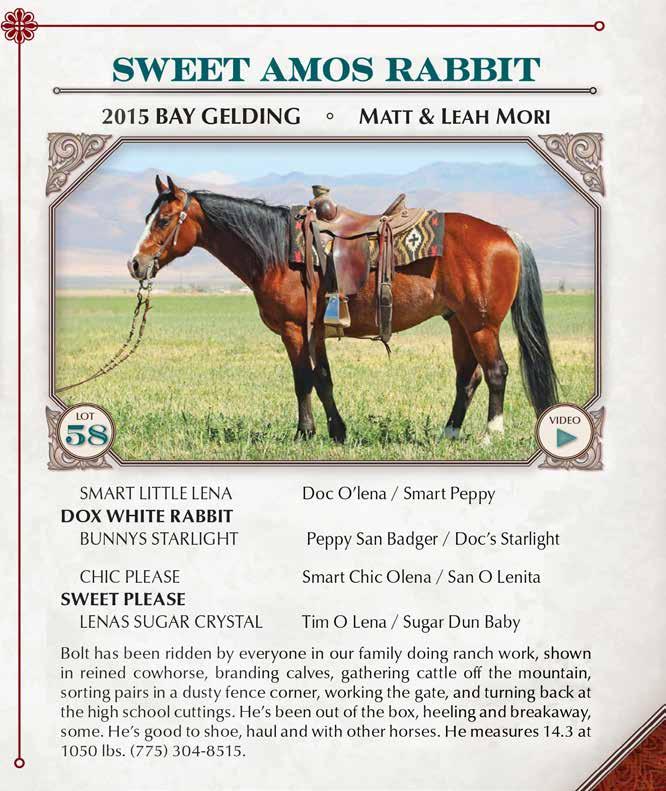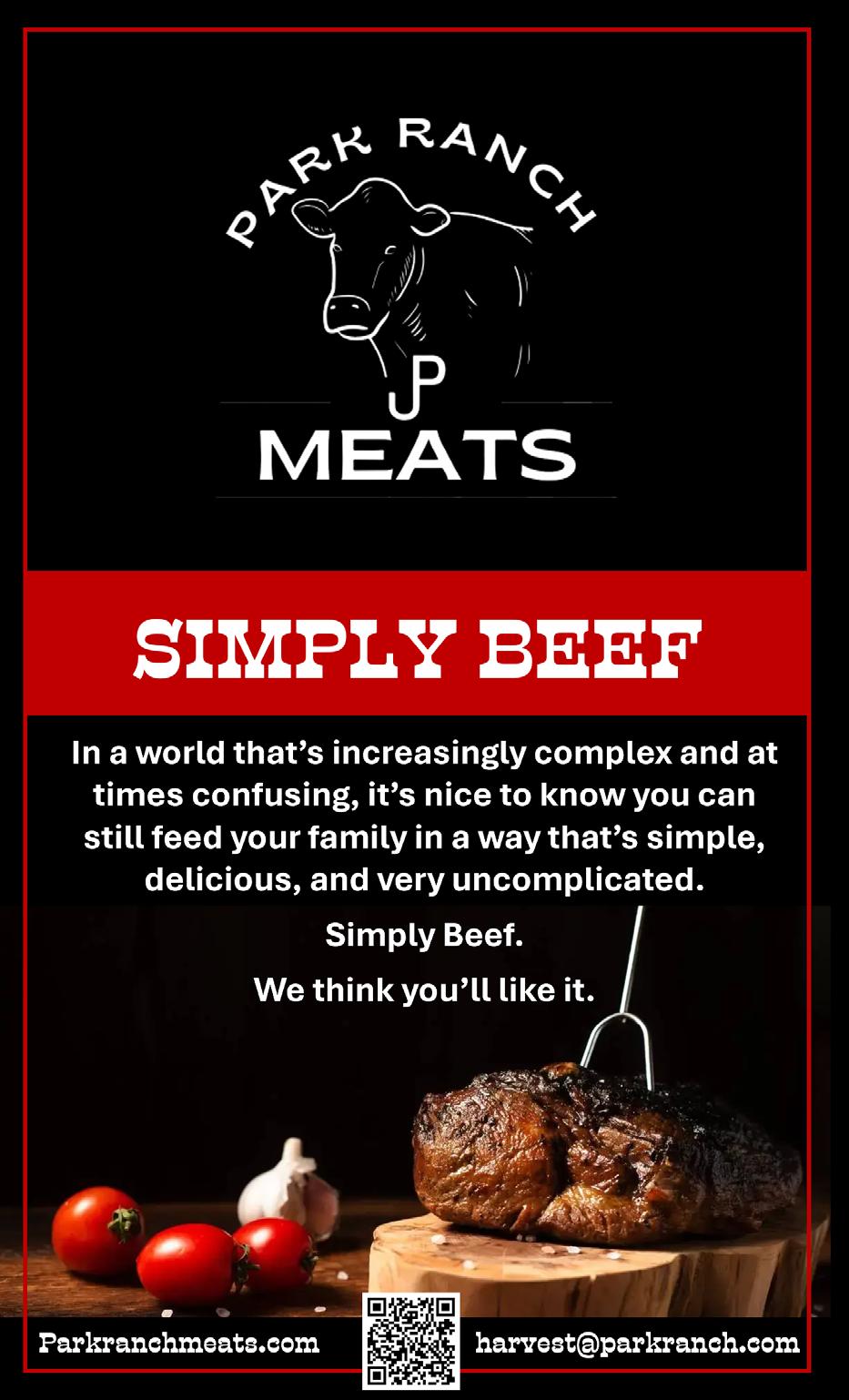

IN THIS ISSUE

Wildfires and Grazing Permits
By Lorrie Boyer
Wildfires have spiked across the West, and while grazing is often a valuable tool in managing land, current challenges are creating issues for grazing permittees.
Kaitlyn Glover, Executive Director of the Public Lands Council, explains: “Over the last 20 years, really, we’ve seen a massive explosion in catastrophic wildfires. Fire generally can be a really good tool, right? We use prescribed fire. We recognize that fire has an important ecosystem role, but when they burn so hot, so fast, and so large, you see again, sort of a conversion of some of these landscapes into annual grasses. Do you see challenges to tree regeneration in some of these more forested ecosystems? And so PLC has been really focused on a few things, and has successfully worked with a number of members of Congress on a bipartisan basis to include more direction and more facilitation to the agencies to do targeted grazing, to do prescribed grazing, to use grazing as that fine fuels management tool.”
Federal grazing permittees often wear many hats, according to Glover, but most are also first responders. PLC is working to expand tools and resources for them, and a major focus has been on strengthening partnerships with the Bureau of Land Management and the Forest Service.
8 times a
View all issues at www.progressiverancher.com
reaches more than 20,000. The views and opinions expressed by writers of articles appearing in this publication are not necessarily those of the editor. Letters of opinion are welcome; submit via email. Advertising rates available upon request. Advertising does not imply editorial endorsement. Liability for errors or omissions in advertisements shall not exceed the cost of the space occupied by the error or omission.







by Martin Paris | NCA Executive Director
| O: 775-738-9214
NCA November Update
I can’t believe it’s already November. Hopefully everyone is surviving a busy weaning and shipping season.
The Nevada Cattlemen’s Association Annual Convention is right around the corner. We have an engaging line up of speakers and events that will surely keep you informed and up to date with issues that impact our industry. At Convention, not only are Nevada Cattlemen’s Association members in attendance, but members of the Nevada Land Action Association, Nevada CattleWomen, Inc., Nevada Wool Growers, Nevada Central Grazing Committee, Nevada Rangeland Resources Commission, vendors that provide services to the beef cattle industry and guest speakers to celebrate the Nevada Livestock Industry. NCA staff and officers are working hard to provide a memorable and educational experience.

HUTCHINGS RANCH | CHURCHILL CO.
Turnkey horse property! 34+/- acres, water rights for 28. Indoor and outdoor arenas, pens and corrals. 6,500 sf 6 bed, 5 bath custom main home, two 3 bed, 2 bath manufactured homes. 3,000 sf greenhouse, orchard and grapevines.
$3,950,000 MLS #3626953


ANTELOPE VALLEY FARM | LANDER CO.
640 acres / 500+ irrigated; 6 agricultural wells, 4 Zimmatic pivots , 50’x60’ shop with concrete floor; 3 bed, 2 bath 1,620 sf manufactured home, detached 680 sf garage. Strong production history of quality alfalfa, Game Mgmt Unit 156.
$2,295,000 MLS # 3624921



Please be sure to come to the convention and learn more about how NCA is working to ensure that Nevada’s livestock industry remains viable and make sure your voice is heard all along the way.
Registration for the convention is at www.nevadacattlemen.org/ events-meetings. If you are interested in attending or would like more information, please call the office at 1-775-738-9214 or email convention@nevadacattlemen.org.
NCA has had a busy few months, including engaging in policy discussions at the annual Public Lands Council (PLC) meeting. During the meeting, we had the opportunity to help set policy that will guide PLC’s mission forward and heard from leadership at various agencies, including Senior Advisor at the Bureau of Land Management Brenda Younkin, U.S. Forest Service Chief Tom Shultz, U.S. Fish and Wildlife Service Director Brian Nesvik, and Deputy Administrator of USDA APHIS–Wildlife Services Jessica Fantinato. Each shared their agency’s vision moving forward under the current administration.
Much like in my last report, there is a clear theme of active management over preservation. I believe we’re in for some positive changes when it comes to the regulatory structure that guides species management, grazing flexibility, project implementation on public lands, wildfire prevention, and several other areas. However, all of these potential changes are just words on paper unless they make it across the finish line when it comes time for implementation on your ranch.
NCA is working hard to ensure that these positive changes are not only adopted, but are also durable and defensible so they can have utility for years to come.
Finally, if you have heifers and steers for sale this fall/winter and are looking to get the best bang for your buck, please consider consigning them to the upcoming Silver State Classic Feeder Sale. The special sale will start at noon on December 2nd at Fallon Livestock LLC in Fallon, NV. Fallon Livestock LLC donates a portion of the sale commission back to the Nevada Cattlemen’s Association which helps us represent you on the issues that matter.
We greatly appreciate their support over the years and hope to see you at the sale.
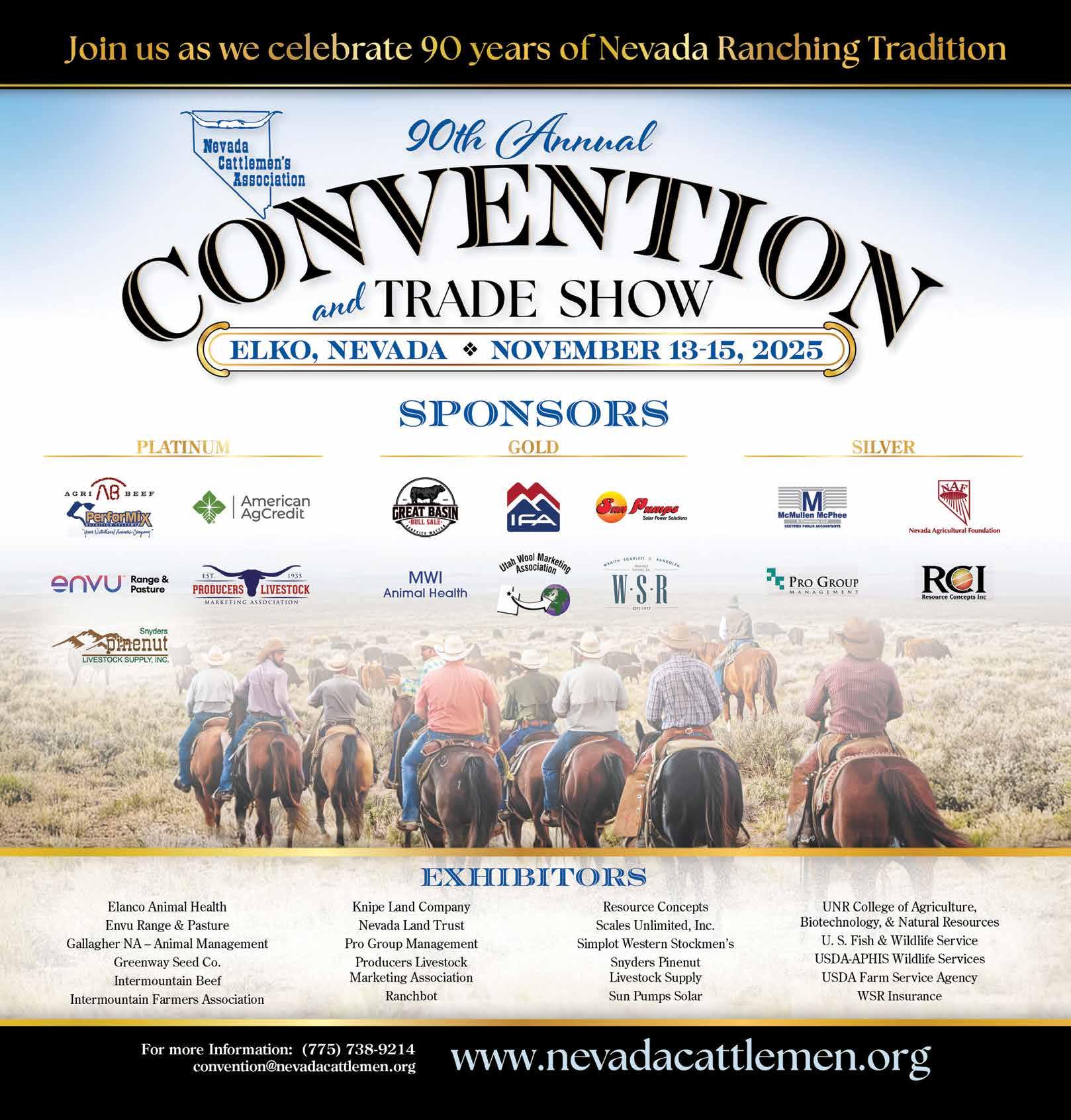
Partnerships in Action: Building a Game Plan
By Christie Van Egmond | Director, Retail & Foodservice Marketing
The annual Partnerships in Action (PIA) conference, held Oct. 13-16 in Denver, Colorado, brought state beef councils from across the country together to learn about the work of the Beef Checkoff. Nevada Beef Council staff attended the conference to learn about how resources and opportunities developed at the national level could be utilized in Nevada. Coordinated by the Federation of State Beef Councils and funded by the Beef Checkoff, PIA strengthens the state and national Checkoff partnership.
Professional baseball player Ty Blach was the event’s keynote speaker and shared how his agricultural roots instilled the drive and work ethic to succeed in baseball. Blach’s parents grew up on Colorado’s eastern plains and the Blach family ranch in Yuma provided many life lessons during his formative years. Growing up, he spent a lot of time on the ranch branding cattle and seeing firsthand how agriculture provides opportunities.
During his presentation Blach stated, “Agriculture is at the heart of who I am and what I do every day.” Blach’s inspirational message focused on the value of teamwork and mentoring others so everyone can be their best. “It is awesome to know state beef councils across the country are working together
to share ideas and to be there for each other,” he said. “Everyone is here for a reason – sharing their passion about beef.”
Topics discussed during PIA highlighted how the National Cattlemen’s Beef Association, a contractor to the Beef Checkoff, and state beef councils work together to drive demand for beef. Attendees learned about program strategy, current consumer trends and preferences, and upcoming Beef. It’s What’s For Dinner. promotions. More than 65 staff members from 30 state beef councils participated in the event, including the Nevada Beef Council.
“When state beef councils gather together and share ideas, everyone wins,” said Christie Van Egmond, Director of Retail & Foodservice Marketing for the Nevada Beef Council. “It is exciting to share what we are doing with others, and I always walk away with a better understanding of the current beef industry landscape, and new marketing concepts we can implement in Nevada to reach consumers.”
The Nevada Beef Council is part of the Federation of State Beef Councils and voluntarily invests in the Federation to enhance the national Checkoff and leverage producer dollars through a coordinated partnership.
About the Federation of State Beef Councils
Created in 1963, the Federation of State Beef Councils represents the 43 Qualified State Beef Councils and is committed to its vision, which is to build beef demand by inspiring, unifying and supporting an effective and coordinated state and national Checkoff partnership. State beef councils voluntarily invest in the Federation to enhance the national Checkoff and leverage producer dollars through a coordinated partnership. Housed at the National Cattlemen’s Beef Association, a contractor to the Beef Checkoff, the Federation is a grassroots organization run by producers across the country.
About Nevada Beef Council
Our Mission: Engage Nevada beef producers and stakeholders with consumer outreach and education to increase beef demand.
Our Values: We provide factual information to consumers and beef producers. We use checkoff dollars efficiently and effectively. We represent the entire Nevada beef industry. www.nevadabeef.org
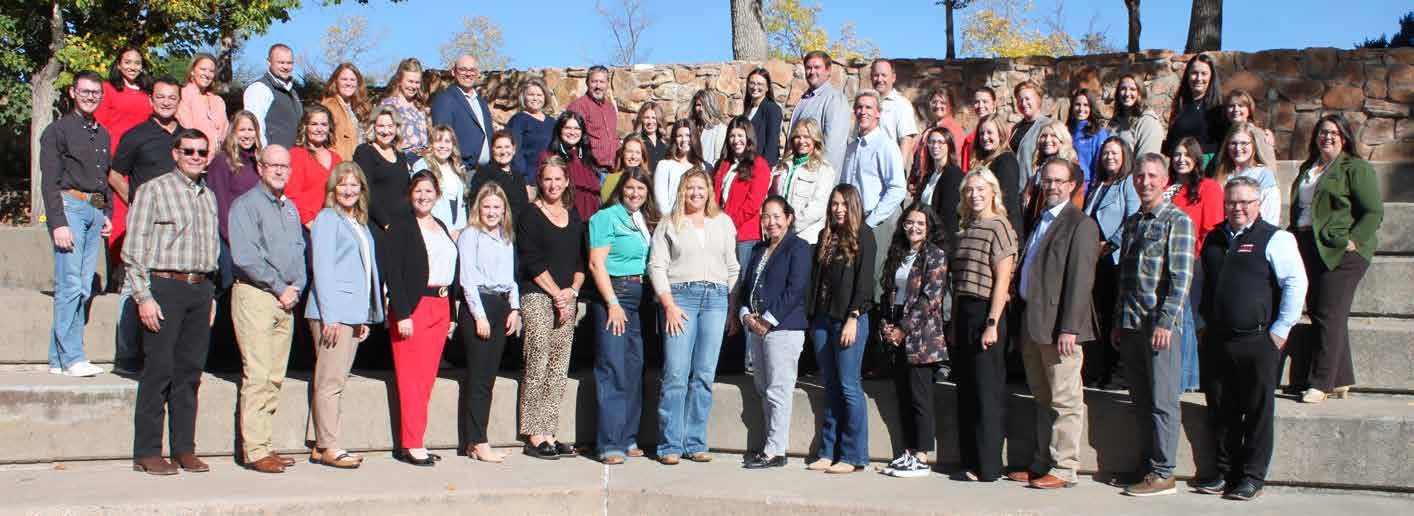

Your Dollar Does


Innovative Marketing Sizzles at Retail
Over the summer, the Nevada Beef Council engaged with consumers in grocery stores across the state through new, innovative digital retail media. The digital campaign brought tasty beef messaging to consumers while they shopped in-store, coupled with a cash-back rebate on beef for their next summertime meal.
The result?

More than 330,000 digital beef ads were shown in-store to consumers.

More than 2,250 consumers added beef to their shopping lists.

660 consumers purchased beef.

For each Beef Checkoff dollar invested, the Checkout 51 rebate offer saw a $5.29 return on investment.


Your Nevada Beef Council continues to explore and launch innovative campaigns to reach Nevada’s consumers with mouth-watering beef messaging to help drive beef demand.
From the Grocery Aisle to the Grill: Innovative Marketing Drives Summer Beef Sales at Retail
By Christie Van Egmond | Director, Retail & Foodservice Marketing
Consumers fired up their grills this summer in Nevada with the help of the Nevada Beef Council (NBC). Spanning from May 18th through September 6th, the NBC’s Summer Grilling campaign covered four major summer grilling moments: Memorial Day; Father’s Day; Fourth of July; and Labor Day. The retail-centric campaign brought tasty beef messaging to consumers while they shopped in-store, coupled with a cash-back rebate on beef for their next summertime meal.
Through a new innovative in-store retail media tactic, the NBC deployed Digital Out-of-Home ads in retail grocery stores in the Las Vegas and Reno metropolitan markets.

This campaign contextually targeted consumers across a variety of premium and highly visible digital screens to remind shoppers in-store of their love of beef while at the point of purchase. The digital beef ads were shown in-store to consumers more than 330,000 times throughout the summer.
The ads showcased beef in its best light with recipe imagery alongside scannable QR codes for easy consumer access to the rebate offer while they were shopping. The cash-back rebate was offered through the Checkout 51 mobile app and online, providing consumers the opportunity to save $1 on their next $10 or more beef purchase for summer grilling.

During the summer-long campaign, more than 2,250 consumers added beef to their shopping lists within the Checkout 51 mobile app, and 660 of those consumers purchased beef and redeemed the offer. Of those consumers, we know that 92% were female, had a household size of 3.49, and were primarily “on-the-go” healthy eaters that like to cook at home. For each Beef Checkoff dollar invested, the Checkout 51 rebate saw a $5.29 return on investment.
The NBC continues to explore and launch innovative retail marketing tactics to reach Nevada’s consumers with mouth-watering beef messaging to help drive beef demand.


Putting Balance on the Plate: Air Fryer Korean Beef
By Kori Dover, RD, Nevada Beef Council
Balanced meals don’t have to be boring. Combining lean protein with flavorful sauces, vegetables, and layered ingredients can create meals that are both satisfying and nutritionally supportive. That might mean using familiar foods in new ways or building variety across the plate with color, texture, and bold flavor.
This Korean-inspired beef recipe does exactly that! With flank steak, sweet potatoes, and a kimchi slaw, it brings together key nutrients like protein, fiber, and essential vitamins and minerals. The air fryer makes the cooking process approachable, helping to make balanced meals easier to enjoy more often. This meal is gluten-free and is a perfect post work out recipe to keep your wellness goals in line.
Ingredients:
• 1 beef Flank Steak (about 1 pound)
• Fresh cilantro and sesame seeds (optional)
RUB:
• 2 tablespoons cornstarch
• 1/4 teaspoon freshly ground black pepper
• 1/8 teaspoon salt
SAUCE:
• 1/4 cup unseasoned rice vinegar
• 1/4 cup sliced sweet onion
• 1/4 cup dates, pitted
• 3 tablespoons coconut aminos
• 1 tablespoon chopped fresh ginger
• 1 tablespoon minced garlic
• 2 teaspoons sesame oil
• 1/4 teaspoon Gochugaru chili flakes (Korean red pepper flakes)
SWEET POTATOES:
• 1 pound sweet potatoes, chopped
• 2 tablespoons water
SLAW:
• 2 cups thinly sliced napa cabbage
• 1/2 cup shredded carrots
• 1/2 cup kimchi, chopped
• 2 tablespoons lime juice


Cooking:
1. Combine rub ingredients. Spray Flank Steak with cooking spray; season with rub. Preheat air fryer to 390°F. Place steak in air fryer basket. Cook 20 minutes or for medium rare (145°F) to medium (160°F) doneness, turning occasionally.
2. Meanwhile, combine rice vinegar, onion, dates, coconut aminos, ginger, garlic, oil and chili flakes in blender container. Cover; process until smooth, scraping sides of container as needed. Set aside.
3. Let steak rest 5 to 10 minutes. (Temperature will continue to rise about 5°F to 10°F to reach 145°F for medium rare; 160°F for medium. Carve steak diagonally across the grain into thin slices.
4. Place sweet potatoes and water in microwave-safe container. Microwave, covered, on HIGH 6 minutes or until tender, stirring once.
5. Combine cabbage, carrots, kimchi and lime juice in large bowl. Toss gently to coat. Let stand or refrigerate, covered, up to 4 hours.
6. Place steak, sweet potatoes and half of sauce in large bowl. Toss gently to coat. Plate with slaw; sprinkle with cilantro and sesame seeds, as desired. Serve remaining sauce, as desired.
www.beefitswhatsfordinner.com
Recipes & photos courtesy of
Conservation & Landscape Health Rule (PLR)
On September 11, 2025 the Department of the Interior, Bureau of Land Management published a notice in the Federal Register for Recission of the “Conservation and Landscape Health Rule” (PLR) which was issued as a final rule on May 9, 2024. Since the beginning of the comment period of this rule PLC has vigorously opposed the rule and led a large coalition of entities who also opposed the rule. The notice is notable for the recission itself and for the rationale expressed by the agency for rescinding the PLR.
There is an admission in the Federal Register in the justification for concluding the PLR is unnecessary and counter-productive to the agency management of public land, that among other things, non-use conservation is not a statutory “multiple use.”
Ironically this is what the opponents of the PLR said from the beginning of their comments. Those opponents, most notably PLC and NCBA, pointed out the obvious- the statutes never listed conservation as one of the multiple uses over which the statute was seeking jurisdictional guidance. However, at least in the grazing permit context, conservation is an implied condition of issuance. Conservation is an ethic not a use. If in actually using grazing lands a rancher must consider the need for
future use and therefore incorporate some conservation of the resource in its use.
Emphatically, therefore, in its comments PLC should once and for all have the BLM state in its recission rule the laws never contemplated conservation as one of the many multiple uses.
Furthermore, other issues in the PLR were opposed by PLC and its coalition partners. These included the unilateral ability of the agency to designate areas of environmental concern (ACECs) without following the procedures outlined in the Administrative Procedure Act (APA). These procedures include the requirement the agency include input from all interested and affected parties.
Another key provision of the PLR glossed over the economic impact analysis required by the statutes. In the hundreds of thousands of comments received by BLM, there was a failure to adequately address the comments expressing concern about the negative impacts if the PLR was fully implemented.
Landowners. Grazing permittees, mining, and timber companies, states, other subsidiary governments (e.g. County Commissions) expressed grave reservations about those negative impacts to rural economies. Many


businesses, as stated in the Federal Register, were named by the representatives of these entities as being harmed by the proposed PLR. These included “beef cattle ranching, natural resource extraction, energy production, energy transmission, and environmental consulting and remediation services.”
Taken as a whole, all of these industries are considered to be vital to the United States as necessary for our independence from foreign influence and intervention. For this reason alone, the PLC comments should emphasize the need to not only criticize the PLR for the above reasons but also point out the government should never try and reinterpret a statute outside of the unambiguous statutory language.
Moreover, if there ever was an example “Chevron Deference” was a wrong approach when questions of following statutory mandates were brought before the courts, this attempt to create a new multiple use is it. The Loper Bright Enterprises v. Raimondo decision by the U.S. Supreme Court is directly on point in saying that agencies must closely follow the unambiguous language in statures passed by Congress.
The Federal Land Planning Management Act (FLPMA) clearly lists those “multiple uses” it considers necessary to make “the most judicious use of the land…. over areas large enough to provide sufficient latitude for periodic adjustments in use to conform to changing needs and conditions.”
These uses included but were not limited to “recreation, range, timber, minerals, watershed, wildlife and fish, and natural, scenic, scientific and historical values. In this unequivocal language, non-use or conservation is not mentioned or implied. Managing use of the nation’s public land was the purpose for which FLPMA was passed. Congress alone could add additional multiple uses by reserving to itself the not limited to language in case there ever was a need to add other uses.
Obviously had Congress intended conservation to be one of those additional uses contemplated to be within the jurisdiction of FLPMA, it could have easily in the original passage of the statute or amendments to it added such as what the PLR was attempting.
Since it did not do this the agency cannot under the new holding in the Loper Bright case add conservation as a use as was attempted in the creation of the Public Lands Rule. I think this might be part of the reason the BLM wants to now rescind.
I’ll see you soon.




The University of Nevada, Reno College of Agriculture, Biotechnology and Natural Resources with financial support from local sponsors
Cattlemen’s Update






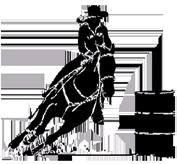


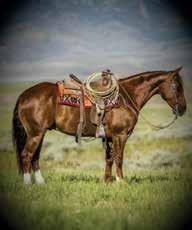

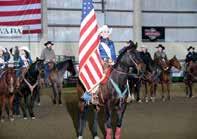
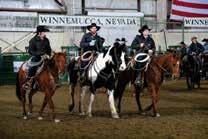




Nevada Farm BureauFarm Bureau Urges Restraint on Beef Imports
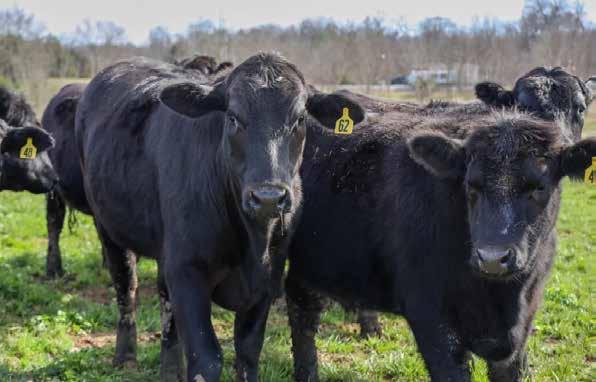
American Farm Bureau Federation President Zippy Duvall commented on President Trump’s plans to reduce beef prices through increased beef imports from Argentina.
“We know America’s families face challenges when food prices rise, but it’s important for President Trump to remember that farmers are facing an economic storm as well, and a vibrant U.S. cattle herd is at stake. Many of America’s beef farmers have operated in the red for several years. Adverse weather and low prices drove cattle herds down to levels not seen in decades. Weakened cattle prices are the last thing needed in farm country, where farmers are being paid historically low prices for crops across the board while expenses remain high.
“We urge the administration to carefully consider the damage importing more beef and cattle from other countries will have as cattle farmers decide whether to invest in rebuilding America’s herds. Just the mention of beef imports created more instability and uncertainty for America’s farmers. Flooding markets with foreign-grown beef could affect our nation’s ability to be food independent in the long-term. We look forward to learning more about the president’s plan, and we stand ready to work with him to ensure farmers and ranchers can survive this economic storm.”
Farm Bureau Letter to President Donald J. Trump
America’s farmers and ranchers are facing extreme economic pressures that threaten the long-term viability of the U.S. agriculture sector. We appreciate your leadership in securing much-needed updates to critical farm risk management programs in the One Big Beautiful Bill Act. However, due to insufficient action over the last several years, an alarming number of farmers are financially underwater as policies have failed to address the spiraling farm economy and provide long-term certainty for American agriculture.
Persistent cost pressures from labor, regulatory compliance, fertilizer, and energy have eroded margins, while weak commodity prices and uneven global competition have strained farm finances. Crop receipts have fallen sharply since 2022, eroding the cash flow and equity farmers rely on to weather downturns, while a growing U.S. trade deficit signals mounting competitive pressure in global markets.
These challenges have been compounded by inconsistent enforcement of trade obligations, including unfulfilled trade commitments from China, and the persistence of non-tariff barriers which have added to the volatility and left farmers with little clarity about future revenue potential or market access.
These trends are not abstract numbers. Across the country, farms are disappearing as families close the gates on the farms tended by their parents, grandparents, and generations before them. Row crop growers producing everything from corn, soybeans, wheat, and sorghum to cotton are being squeezed out, not because of poor yields, but because market prices have fallen well below the cost of production. The same story echoes across fruit and vegetable regions, where entire orchards are being bulldozed under the weight of soaring labor, input, and compliance costs that far exceed returns.
More than half of U.S. farms now lose money each year, forcing families to rely on off-farm income just to survive. Every farm lost takes with it generations of knowledge, community leadership, and the heartbeat of local economies: fewer kids in schools, fewer trucks at the grain elevator, fewer small businesses that keep rural towns alive. As those farms disappear, so too does America’s food independence: our ability to feed ourselves without relying on foreign supply chains.
The American Farm Bureau urges your Administration and Congress to take action to stabilize and strengthen the farm economy and build a foundation for economic viability sector wide.
In the short term, we urge leaders to authorize bridge payments for farmers before the end of 2025. These payments must be robust enough to address sector-wide gaps and provide meaningful support as the federal government works to recalibrate trade strategies, stabilize prices, and strengthen key market relationships.
We call for a renewed national commitment to U.S. agriculture through swift, decisive action on policies that restore farmers’ ability to stay in business, to rebuild market access and secure the financial resilience of the rural economy. The following policy actions will help ensure that farming provides a dependable living for the farm families who work tirelessly to feed, clothe, and fuel the world:
• Fair and enforceable trade agreements that open markets and ensure reciprocal access for U.S. products;
• Policy support for biofuels, including year-round sales of E15 and other renewable fuels;
• Restoration of whole milk in schools, giving children access to nutritious U.S. dairy products;
• Protection of interstate commerce by opposing and challenging current or future state laws that undermine market consistency, competition, and transparency;
• Investigation into pricing structures for major agricultural inputs to address market imbalances that artificially inflate production costs beyond normal market fluctuations, paired with stronger enforcement of laws and regulations that ensure transparency and fairness in agricultural markets;
• Prioritization of American-grown fruits and vegetables in federal and institutional purchasing programs.
American agriculture has always been a strategic national asset—vital not only to our economy but to our food security and independence. Federal leadership can now prevent a deepening crisis by taking steps to preserve our agricultural infrastructure and ensure the next generation of farmers and ranchers can continue feeding the world.
Mr. President, we appreciate your longstanding support for rural America and respectfully request your Administration work with congressional leaders to provide the relief and reform urgently needed to sustain our nation’s farmers and ranchers.

Zippy Duvall, President, AFBF
CC: The Honorable Mike Johnson, Speaker of the House The Honorable John Thune, Senate Majority Leader The Honorable Chuck Schumer, Senate Minority Leader The Honorable Hakeem Jeffries, House Minority Leader The Honorable Scott Bessent, Secretary, United States Department of the Treasury The Honorable Brooke Rollins, Secretary, United States Department of Agriculture

Happy Nevada Day!
News from the desk of NDA DIRECTOR GOICOECHEA

As we look forward to Nevada Day, let’s take a moment of appreciation for Nevada’s farmers and ranchers. Our producers are busy this harvest season, and this hard work does not go unnoticed. Their dedication to providing food, fuel and fiber in the heart of the golden west is no easy feat.
I also want to thank our sister agencies and our community partners working diligently with us to help offset the impacts of those who may be experiencing food shortages during the federal government shutdown. It takes a team, but at the end of the day, we can always depend on our fellow Nevadans.
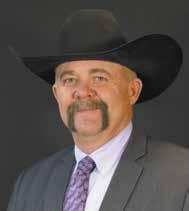
JJ Goicoechea
JJ Goicoechea, Director Nevada Dept of Agriculture
405 South 21st Street Sparks, NV 89431

NOMINATE Taste of Nevada Small Business of the Year
The NDA and Made in Nevada are seeking nominations for the annual Taste of Nevada – Small Business of the Year Award, recognizing the outstanding work agriculture, food and beverage industries do in Nevada. Nominations are encouraged for any Nevada small business that provides locally produced agriculture, food or beverage products. Businesses are also able to self-nominate. To be eligible, businesses must be licensed in Nevada, produce or manufacture at least 51 percent of their agriculture, food or beverage product in Nevada and have less than 150 employees. Nominations are due by Nov. 17, 2025.
Fill out the nomination form here: https://nvagri. qualtrics.com/jfe/form/SV_cOcrF7A69B84vVY

Support the NDA State Fair at the UNR v. San Jose game on November 15
The NDA is hosting the first Nevada Department of Agriculture State Fair in June of 2026. To support funding of the fair, we will be fundraising at the UNR Wolf Pack game against San Jose State on Nov. 15. A portion of ticket sales go back towards supporting the fair, and we will be collecting donations during the tailgate in spot 318.
BUY TICKETS: https://www.gofevo.com/group/nvstatefair
Can’t make it, but still want to contribute? Donate here: https://tinyurl.com/NDA-State-Fair-2025
Hope to see you there!

Food Distribution Program on Indian Reservations offers cooking demonstrations
The NDA Food Distribution Program on Indian Reservations (FDPIR) was joined by Chef Travy for cooking demonstrations using ingredients participants have access to through their food distributions. Through this programming, participants got to taste and learn how to make beef and bison meatballs in a tomato sauce and a wild rice soup, as well as ask questions about nutrition and cooking techniques.
Crunching through Farm to School Month
Nevada celebrated its first ever Crunch Day this October as part of National Farm to School Month! Schools and communities across Nevada participated by crunching into locally grown fruits and vegetables to promote healthy eating and local agriculture.
https://agri.nv.gov/Food/Farm_To_School_Program/ Farm_to_School_Program/
Reminder: Electronic Identification tags are required for regulatory purposes
Per the USDA and a change in 2024 to the Animal Disease Traceability (ADT) rule, livestock owners are required to use electronic identification ear tags (EID) to allow for real time animal tracing to help mitigate disease outbreaks, and allow for continuity of commerce. There is NO CHANGE to the animals requiring tags to move interstate, only the type of tag is changing. Beef cattle under 18 months of age being shipped do NOT need an EID for interstate movement unless required by the destination state. All dairy cattle and cattle used for rodeo, shows and exhibition require EID, regardless of age. Cattle that already have non-electronic official identification, such as a metal brite tag or metal brucellosis vaccination tag, applied before Nov. 5, 2024, may continue to use that tag for the span of its life.
A limited supply of EID tags will be available through the NDA at no cost. Issuance of EID tags will require a National Premises ID Number (NPIN) first be assigned to the home location of the cattle, obtained from NDA.
To request EID tags, have your veterinarian apply at https://hal.nv.gov/form/NDA/RFID_EID_Request_ Form.
To request NPIN, apply at https://hal.nv.gov/form/ NDA/Nevada_Location_Form.
For more information on this USDA ruling please visit https://www.aphis.usda.gov/sites/default/files/ traceability-faq.pdf




PLC Honors Awardees as Annual Meeting Closes
FLAGSTAFF – During their 57th Annual Meeting, the Public Lands Council (PLC) honored two individuals who have made significant contributions to the federal lands ranching community. PLC Secretary and Colorado grazing permittee Robbie LeValley was selected for the 2025 President’s award and Dr. Karen Launchbaugh, a professor at the University of Idaho, was selected as the 2025 Friend of PLC.
PLC President Tim Canterbury recognized PLC Treasurer Brenda Richards, who runs a cow-calf operation in Reynolds Creek, Idaho, for her outstanding leadership on the local, state, and national levels. As a fourthgeneration rancher in the state, Richards has set the standard for Colorado ranching. When she’s not working on the ranch, she volunteers her time with several different livestock industry organizations. She volunteers her time to the National Cattlemen’s Beef Association, Idaho Cattle Association, Nevada Cattlemen’s Association, and Boise’s District Bureau of Land Management Resource Advisory Council.
“When I started to attend national industry meetings Brenda was already an established leader and had been effectively fighting for our industry for years. From testifying in Congress, leading PLC and working on ranching issues – grazing permittees are all better off because of her leadership,” said PLC President Tim Canterbury. “Spending time away from the operation can be costly but her work to cut government red tape is essential to advancing this industry. There is no one more deserving of the President’s award and I am proud to serve with her as a PLC Officer.”
PLC Vice President Ron Cerri recognized Dr. Karen Launchbaugh as the 2025 Friend of PLC. Dr. Launchbaugh has worked as Professor of Rangeland Ecology at the University of Idaho, providing ranchers with the latest research on grazing and rangeland management as well as educating the next the generation on the benefits of grazing. Her immense research and teaching career has advanced rangeland education further than anyone and her work studying livestock behavior while grazing has been hugely beneficial for ranchers and students alike.
“The Friend of PLC award is for the rare individuals, that while they may not be ranchers, they advance the ranching industry to that next level. Dr. Karen Launchbaugh is not only a great friend to grazing permittees, but she is also a friend and mentor to students looking to work in the field of rangeland and ecological research,” said PLC Vice President Ron Cerri. “Livestock producers owe so much to Dr. Launchbaugh for her work advocating for and advancing this industry – whenever a rancher says science-based, chances are it is because of her work that we get to definitively say that. Future generations of ranchers will learn from her extensive work on rangeland and grazing research, becoming better ranchers because of it and that is a true friend to the ranching industry.”
NDA welcomes Bryant McDowell as new State Entomologist
(SPARKS, Nev.) – The Nevada Department of Agriculture (NDA) has named Bryant McDowell as the new State Entomologist with the Division of Plant Health and Compliance. McDowell will be tasked with protecting Nevada’s agricultural and natural resources from invasive pests, support statewide plant health programs and manage the NDA Entomology Laboratory and collection.
A Texas native, McDowell earned both his Bachelor of Science and Master of Science degrees in entomology from Texas A&M University, where his graduate research focused on the population genetics and colony breeding structure of the invasive tawny crazy ant (Nylanderia fulva). His laboratory experience includes work with Aphelinus parasitic wasps, kissing bug dissections, and blood-meal analyses for trypanosome detection. While at Texas A&M, he also built a strong teaching and outreach portfolio, serving as lead teaching assistant for veterinary entomology, organizing FFA and 4-H insect identification clinics, and mentoring students in applied entomology. After returning to Texas Hill Country in 2020, he taught high school forensics, anatomy and physiology before joining Texas A&M AgriLife Extension in Dallas as a program specialist from 2022 to 2024. There, he managed the IPM House training facility, delivered integrated pest management education, and provided statewide continuing education unit trainings.
“We are thrilled to welcome Bryant into this critical role,” said NDA Division of Plant Health and Compliance Administrator Meghan Brown. “His academic training, field experience and passion for public education will be instrumental in protecting Nevada’s agricultural integrity and supporting our producers.”
The Nevada Department of Agriculture (NDA) mission is to preserve, protect and promote Nevada’s agriculture. The department has 225 dedicated employees providing services in its five divisions, Administrative Services, Animal Industry, Measurement Standards, Food and Nutrition, and Plant Health and Compliance. The department’s $288 million budget facilitates regulatory and administrative work in agriculture and food manufacturing industries, protecting public and environmental health and worker safety, and providing food distribution and oversight for the United States Department of Agriculture’s school and community nutrition programs.
Brenda Richards
Bryant McDowell
Nevada Farm Bureau
Support BLM Rescinding The 2024 Public Lands Rule
By Doug Busselman | NFB Executive Vice President
The September 11th, 2025, Federal Register shared that the Bureau of Land Management (BLM) is proposing to rescind the Conservation and Landscape Health Rule “in full and seek comment on that proposal.” It would be a very good idea for Nevada ranchers and others who care about multiple use of BLM’s public lands to rise to the occasion and comment on the proposal, supporting the rule being rescinded. The deadline for submitting public comments is November 10, 2025.
Throughout the Federal Register notice the current administration’s BLM officials presented a strong case for how the past administration took improper routes in process and violated several existing statutory requirements in ramming through their misguided rule through. The Federal Land Policy and Management Act (FLMPA), a law written and passed by Congress and then signed into law by the President, establishes that BLM is supposed to “manage public lands under principles of multiple use and sustained yield, except where the land has been dedicated to a specific use by other provisions of law.”
The BLM bureaucrats pushing the 2024 Rule into operation took it on themselves to invent their own law – by their own authority.
“The BLM is charged by statute to regulate the ‘use, occupancy and development’ of public lands in accordance with the principles of ‘multiple use’ and ‘sustained yield,” the September Federal Registered noted. “But the Conservation and Landscape Health Rule identifies conservation – a non-use –as a productive use for leases and permits. This is contrary to BLM’s mandate and statutory authority. Conservation is not a ‘use’ under statute.”
How They Got Themselves Where They Wanted To Be
The current leaders of BLM note that the past group was the less than honest in using the process they did to authorize themselves to carry out the decision without following the full National Environmental Policy Act. Instead, they determined they could get by with a Categorical Exclusion. This was based on the agency’s self-economic analysis the Rule was “not anticipated to have wide-reaching impacts.”
There were 216,403 public comments submitted, and BLM formally considered 152,673. It is highly likely that there were a number of commenters who pointed out that the Rule would have “wide-reaching impacts.” It is even harder to imagine that something on this scale could have thought that it wouldn’t have “wide-reaching impacts.” Then again when you believe yourself to have all the power you need to make a self-serving mission come to past, you will decide whatever gets you to where you want to go.
Nevada Farm Bureau was one of those providing comment that the proposed 2024 Rule did have wideranging impacts.
“BLM is responsible for managing nearly 48 million acres of land in Nevada, accounting for about 63 percent of our state’s land base.” Nevada Farm Bureau wrote. “How BLM manages this land and the policies which guide their management activities are important to Nevada citizens in general and especially critical for Farm Bureau members who depend on access and use of renewable resources on BLM-managed lands.”
From a more national perspective the U.S. Small Business Administration’s Office of Advocacy in their June 13th letter explicitly stating, “BLM’s proposed rule does not adequately consider the impacts to small businesses as required by the Regulatory Flexibility Act (RFA).”
The U.S. Small Business Administration’s Office of Advocacy, went on further in their letter stating…
“B. The proposed rule lacks a proper factual basis for certification that the rule will not have a significant economic impact on a substantial number of small entities.”
Further it was noted, “Under § 605 (b) of the RFA, if an agency certifies that the rule will not have a significant economic impact on a substantial number of small entities, they must include a factual basis for such certification. BLM’s certification provides no such factual basis and offers no information as to how they arrived at this conclusion.”
The current BLM team working on the rescission has said in the Notice, “In re-evaluating the 2024 Rule the agency is taking a closer look at those public
comments and believes they raise important questions about whether the economic impacts of the 2024 Rule were materially underestimated.” If you would like to say something about this area in your comments this time, the BLM is asking for comments.
End Around Rules For ACECs
Another area that will be given consideration in the process of rescinding the entire 2024 Rule deals with what is stated as being, “The 2024 Rule also unlawfully and unnecessarily expanded the scope of the BLM’s regulations governing the designation and management of Areas of Critical Environmental Concern (ACEC).”
BLM currently is taking the position that the 2024 Rule denies opportunities for public participation where it could be considered whether the ACEC designation is even warranted. The intentions of the Conservation and Landscape Health Rule were to provide another tool to close off multiple use with an arbitrary decision, by a BLM official, to treat the lands being sought to be included as ACEC as if they were ACECs. If there was an intention to following the ACEC regulations that BLM is supposed to follow, the process would include proposals for ACEC designations to go through land use revision plans and public input.
From the Federal Register language, we can expect the ACEC rules to return to where they were and comments are welcome on how to make these rules even better. Requiring that proposals be included with each ACEC request identifying what needs to be done to address the area of concern as well as what will be done to monitor whether it is getting corrected in the process of having the environmental concern fixed. Because ACECs are as important of designations as they are, it would be good for a complete inventory completed, documenting every ACEC and itemizing why it was designated and what has been accomplished since being designated.
Something must be done to get rid of the changes that the Conservation and Landscape Health Rule sought to accomplish. The way that the BLM hierarchy at that time overstepped their boundaries were wrong. Similar efforts in the future will not be acceptable. Thank you to those involved who are now working to get rid of these attempts to worm their anti-use agenda through.
Connect, Learn, Celebrate! Register for the 106th Annual Meeting Now Take the Stage: Compete in Nevada’s YF&R Discussion Meet
By Brittney Money | NFB Director of Communications
The Nevada Farm Bureau’s 106th Annual Meeting is more than just a gathering—it’s a celebration of agriculture, a chance to learn, and an opportunity to make your voice heard in shaping the future of farming in our state.
Taking place November 12–14, 2025, at the Winnemucca Convention Center, this event will bring together farmers, ranchers, and agricultural leaders from across Nevada for three days of connection and growth.
Attendees will hear the latest updates on agricultural policies and legislative priorities, gain new insights through workshops and educational sessions, and explore the challenges and opportunities facing Nevada agriculture today. The meeting also offers meaningful networking with fellow members and industry leaders, recognition of outstanding contributions to agriculture, and a chance to cheer on the Young Farmers & Ranchers Discussion Meet competitors. A special ag tour highlighting a Winnemucca mine will add to the unique experiences this year’s agenda has to offer.
Whether you are a longtime Farm Bureau member or new to the agricultural community, this meeting is your opportunity to get involved, celebrate the strength of Nevada agriculture, and be inspired by the hardworking people who make it thrive.
Registration is now open, and we encourage you to register early. Space for the tour is limited, so be sure to register early to secure your spot and avoid missing out on this special opportunity. Registration will close November 5th. Please register today using the QRC below or here: www.nvfb.org/events/106th-nevada-farm-bureau-annual-meeting/
Make sure your voice is heard. Register today for the 106th Nevada Farm Bureau Annual Meeting!


By Brittney Money | NFB Director of Communications
Are you ready to challenge yourself, expand your agricultural knowledge, and connect with other passionate young leaders?
The Young Farmers & Ranchers (YF&R) Discussion Meet is your chance to do just that—and we want YOU to participate!
Held each year during the Nevada Farm Bureau Annual Meeting, the YF&R Discussion Meet simulates a real committee setting where participants discuss important agricultural topics. Competitors are judged on their ability to communicate effectively, collaborate with others, and offer thoughtful solutions. This isn’t a debate—it’s about building consensus and demonstrating how emerging agricultural leaders can tackle real-world challenges together. Who Can Compete? | The Discussion Meet is open to young adults between the ages of 18 and 35 who are ready to showcase their leadership skills.
Why You Should Compete | Participating in the Discussion Meet is a unique opportunity to sharpen your public speaking and discussion skills, explore current issues in agriculture, network with fellow young professionals, and potentially represent Nevada on the national stage.
Cash Prizes: • 1st Place: $500 • 2nd Place: $300 • 3rd Place: $150 • 4th Place: $50
The Nevada state winner will advance to compete at the national level—either in the American Farm Bureau Federation Discussion Meet or the Collegiate Discussion Meet, depending on eligibility.
The 2026 Discussion Meet questions are available by scanning the QR code and will be used during the 106th Nevada Farm Bureau Annual Meeting. Don’t miss this chance to grow as a leader, win prizes, and make your voice heard! Interested in competing or have questions? Contact Brittney Money at brittney@nvfb.org.

Nevada Water Solutions LLC
Water Rights / Resource Permitting Expertise
Thomas K. Gallagher, PE
775 • 825 • 1653 / FAX 775 • 825 • 1683
333 Flint Street / Reno, NV 89501 tomg@nevadawatersolutions.com
Nevada Farm Bureau Grassroots News
Nevada Farm Bureau Resolutions Committee Meet In Preparing For Voting Delegates
County Farm Bureau representatives met with other members of the Nevada Farm Bureau Resolutions Committee on Thursday, October 30, 2025, to prepare their report to the Nevada Farm Bureau Voting Delegates. The Nevada Farm Bureau Voting Delegates will take this report and deliberate what Nevada Farm Bureau policy should be for 2026. A few of the discussion areas, covered in proposals for new policy, include Conjunctive Management of surface and groundwater; data centers, solar fields and protection of agricultural lands. What to do about growing elk herds and the damages caused to agricultural crops.
Nevada Farm Bureau Voting Delegates will meet as part of the 106th Annual Meeting in Winnemucca on Friday, November 14th. There will also be a number of timely information meetings scheduled for Thursday, November 13th. If you haven’t already done so –Register and make arrangements to attend the 2025 Nevada Farm Bureau annual meeting! Visit https:// www.nvfb.org/events/106th-nevada-farm-bureauannual-meeting/
Stack Up Some Fun at the Women’s Leadership Pancake Breakfast!
Join us for a delicious morning of fluffy pancakes, great company, and inspiring conversations with women who make a difference in agriculture and our communities. It’s the perfect way to kick off the Friday morning at this year’s 106th Nevada Farm Bureau Annual Meeting. You won’t want to miss it. Register at www.nvfb.org now and save your seat at the table.
University of Nevada, Reno Opens Main Station Farm Science Center
The University of Nevada, Reno celebrated the grand opening of its Main Station Farm Science Center on October 10. Hosted by the College of Agriculture, Biotechnology & Natural Resources, the new facility is designed to boost hands-on learning, research and innovation in animal, meat and veterinary sciences.
Guests toured the new labs, smart classroom and upgraded Wolf Pack Meats and feedlot facilities. University leaders, including President Brian Sandoval, highlighted the Center’s role in strengthening Nevada’s food systems and agricultural workforce.
Featuring advanced classroom technology, a specialized Web Lab, and flexible meeting spaces, the Science Center will enhance student education and research while supporting Nevada’s agriculture and meat industries.
This new addition marks a major investment in the state’s agricultural future and food security.
Latest Farm Bureau Market Intel Report Covers Economics of US Beef And Cattle Markets
Last week’s newsletter covered the dust-up taking place as a result of a communications “tweet” that President Donald Trump sent out on bringing in some additional Argentina beef, lifting the current lower tariff rate of 20,000 metric tons to 80,000 metric tons at the same rate. We also shared the response that American Farm Bureau Federation (AFBF) President communicated to the Trump Administration.
This week we have AFBF Economist, Bernt Nelson, sharing his insights on the “Economics of US Beef and Cattle Markets”
“On Oct. 23, the administration announced it would increase the tariff rate quota for beef from Argentina in an attempt to lower consumer beef prices.” Nelson wrote, continuing, “Since 2020, about 2 percent of U.S. beef and veal imports have come from Argentina. Under the current tariff rate quota, Argentina can sell 20,000 metric tons of beef per year to the U.S. at a lower tariff. After the quota is met, the tariff increases. So far in 2025, about 30,000 metric tons of beef have been imported from Argentina, about 10,000 metric tons above the tariff rate quota and over 40 percent higher than last year. An increase to 80,000 metric tons would account for about 3.5 percent of the total U.S. beef import volume to date and about 0.6 percent of USDA’s forecasted U.S. beef consumption for 2025. This amount will not have a measurable impact on prices consumers pay for beef, but the announcement has already caused future prices for feeder cattle to fall by 7 percent.”
Pilot Program Seeking Interested Participants Who Are Feed Up With Open Gates
Nevada Farm Bureau has been in discussions with the Nevada Department of Wildlife (NDOW) on a pilot program that they are working on. They are sending a grant request to the Nevada Off Highway Vehicle (OHV) Commission. The pilot program they are working to establish would involve installation of several cattle guard units and a number of gate monitoring (Track Tags) which landowners who have to deal with gates that get left open (when they are supposed to stay closed) or gates that get closed (when they are supposed to be kept open).
There is a quick turnaround to meet the obligations of gaining commitments to participate before the deadline passes to submit the grant request. The deadline is Friday, November 7th.
The “Track Tags” are a monitoring system which monitor on a real-time basis whether a gate is open or closed and allows for the owner to be able to take whatever appropriate action that is necessary. NDOW
has an application letter that needs to be completed in order to get plugged into whatever the grant proposal will entail:
THE LANDOWNER MUST PROVIDE A LETTER
• All projects must submit a landowner letter for the area the project will take place. If the applicant is the landowner, managing agency, or has jurisdiction over the location the project will take place, the applicant must still submit a landowner letter.
• The letter must be project specific and dated from the current application year.
• The letter must include:
a)Landowner has read the Request for Grant Application package.
b)Landowner agrees with the application and the terms of the grant.
c)Landowner holds an interest in the subject land that is sufficient in scope and authority to allow the applicant to complete the proposed project and operate and maintain the proposed project after its completion.
d)Landowner is legally committing to maintain the trail/facility and will allow public motorized access to such trail/facilities for 25 years or the normal life of the project; and
e)Landowner agrees to provide any match or other tasks in the application that are assigned to Landowner.
f)Landowner includes location of the installation (GPS coordinates, preferred).
If you are interested in learning more, contact Cody McKee at NDOW – (775) 688-1525 or email dmckee@ndow.org
Big Issues, Bigger Impact, Join the Discussion at Annual Meeting
This year’s Nevada Farm Bureau Annual Meeting is packed with breakout sessions designed to help farmers and ranchers stay informed and engaged on the issues that matter most.
One highlight includes a visit from the State Water Engineer, who will discuss management plans and updates for the Humboldt River. A critical topic for producers across the region, but especially in Humboldt county. In addition, Shelby Hagenauer from the American Farm Bureau Federation will provide a legislative update and share insights on the importance of grassroots involvement in shaping agricultural policy.
These sessions, along with others throughout the meeting, offer valuable information, networking and discussion opportunities to strengthen Nevada agriculture. Be sure to attend, connect and learn!
If
looking
a farm or ranch, give us call!
New Terms on Fish Creek Ranch in Eureka Co.
Now Offering to sell 100% interest in the ranch. Lots of irrigation water from springs that arise on the ranch. Mine owner wants to reserve some water rights and Sage Grouse credits and 100 acres off the East side for a future Man Camp. Mine would pay for the Sage Grouse Credits at the new price: Over 2597 deeded with approx. 1000 acres water righted out of the Springs. 5 homes plus multiple other outbuildings. Price: $4,000,000.
Humboldt
River Acreage with Water Rights
650 acres on the Humbold River with over 300 acres of surface water rights. Just East of Elko approx. 13 miles. Has access onto the Ryndon Exit. With the new conjunctive management of water by the state, this should add future value to this property. Price reduced! $1,200,000 $950,000



Consignment Deadline: November 13

©Venturacci

THE ROUNDUP
An analysis of western ranching politics.
IN THE NEWS
Senate: Wildfire bill advances with litigation limitations.
Emergency language in wildfire bill splits environmentalists, E&E News - A fast-moving bill to reduce wildfire risks in national forests would give the Agriculture Department a work-around past even the bill’s modest environmental safeguards, making the measure tough to swallow for some environmentalists and Hill Democrats. The “Fix Our Forests Act,” S. 1462, which advanced out of the Senate Agriculture, Nutrition and Forestry Committee with bipartisan support earlier this month, would give the Agriculture secretary wide latitude to declare “emergency” situations on millions of acres of federal land. The language in the bill would provide even faster forest work than the rest of the legislation envisions and offer limited opportunity for the public to object. The legislation has built momentum and is now raising alarms among environmental groups that oppose it. The House passed a similar bill earlier this year with 60 Democrats joining Republicans on the effort. “This administration is redefining what we call an emergency,” said Ellen Stuart Haentjens, executive director of the Virginia Wilderness Committee, a nonprofit environmental group. The “emergency” designation is so broad, she said, it could encompass projects that have more to do with harvesting timber than preventing wildfires. The legislation spells out a couple of scenarios for fast-tracked thinning and logging, which advocates say will help prevent the worst wildfires by depriving them of potential fuel. First, the bill calls for bigger “categorical exclusions” from the National Environmental Policy Act — growing from 3,000 acres to 10,000 acres for some types of projects in the high-risk firesheds — and would place new limitations on legal challenges. One new categorical exclusion in the bill would allow for quicker removal of “hazard” trees that could harm wildland firefighters, for instance. Categorical exclusions pare back NEPA reviews based on a finding that projects won’t cause environmental harm. Then, the bill would allow the Agriculture secretary to also declare an emergency in any of those places, further speeding the process and limiting public comment. Around 250 areas
in the Western U.S. already have the highest-risk designation from the Forest Service, and the bill spells out a process for adding more.
BLM: OR rancher speaks about the recent cattle industry developments.
Feds propose opening up more public lands for cattle grazing in Oregon, Western states, OPB - Cattle ranchers in Oregon and across the nation have found their work in the national spotlight with policy proposals from the Trump administration that have drawn both outrage and skepticism from industry groups. One proposal, which has drawn national headlines and pushback from U.S. cattle industry groups, would import beef from Argentina to lower prices at the grocery store. The other seeks to open more public lands to cattle ranching and has drawn more mixed reviews. “The announcement of both things just happened to be at the exact same time,” said Matt McElligott, the president of the Oregon Cattlemen’s Association and a North Powder rancher. Earlier this month, the Trump administration released its plan to support domestic cattle ranchers. Industry groups and government officials say it had been in the works for several months. The plan calls for opening up more public lands for grazing and Endangered Species Act reforms, among other changes. The Oregon Cattlemen’s Association expressed some skepticism but sees some upsides. Wildlife and conservation groups say the plan would benefit only a handful of politically connected producers at the expense of the environment. “There seems to be a big focus here on further handouts to public lands grazers,” said Adam Bronstein, the Oregon director for the Western Watershed Project, a nonprofit conservation group. When the U.S. Department of Agriculture released a 13-page plan to “strengthen” the U.S. beef industry, McElligott said he was unconvinced at first. “I’m skeptical of government intervention in any market. That’s my first impression,” he said. “Then I read the plan, pulled it apart, looked at it, and thought there’s some good stuff in there.” The plan would open up more than 24 million acres of vacant grazing allotments that are managed under the Bureau of Land Management and the U.S. Forest Service across much of the Western United States.
Trade: No date set for border reopening.
Mexico: Still No Date to Resume Beef Exports to the U.S, American Ag Network - Mexico and the U.S. have not yet reached an agreement to resume Mexican beef cattle exports to the U.S. as the outbreak of the New World Screwworm continues in Mexico. Agriculture Minister Julio Berdegue announced the update during a press conference with President Claudia Sheinbaum. Berdegue said he spoke with U.S. Agriculture Secretary Brooke Rollins via video conference, where both sides reported progress but confirmed there is still no timeline for reopening the U.S. border to Mexican cattle. The two agriculture leaders agreed to begin testing modular mobile facilities in Mexico designed to boost the production of sterile flies—a key component
of the screwworm eradication program. If successful, these mobile units could increase sterile fly production by as many as 20 million flies per week, significantly strengthening efforts to contain the outbreak. The sterile flies are released to mate with wild screwworm flies, effectively reducing the pest population over time. Since May, the U.S. government has maintained a near-total closure of its border to Mexican cattle imports to prevent the spread of the parasite. The New World Screwworm, a flesh-eating fly larva, poses a deadly threat to livestock by infesting open wounds and causing severe tissue damage. The outbreak has spread northward from Central America into Mexico, alarming livestock producers and trade officials across both countries. Officials say the cooperation between U.S. and Mexican animal health authorities will be critical to restoring trade safely while ensuring the screwworm does not reenter U.S. herds.
Wolves: Ranchers continue to fight with wolf protections.
Mexican Gray Wolves vs. Arizona ranchers: A battle reaches Capitol Hill, Fox10 Phoenix - The age-old battle between predator and prey is pushing some Arizona ranchers to the nation’s capital. The decision to place Mexican Gray Wolves on the protected species list is putting cattle farmers across the Southwest in a difficult position, raising debate over conservation and livestock losses, or depredation. The first captive wolves were released into the wild in 1998 as part of the U.S. Fish and Wildlife Service’s recovery efforts. Local perspective: The debate is personal for the Marks family, an Arizona ranching family based in Blue, Arizona. Rancher Ginger Cheney recalled finding a calf, Manuka, this spring after a wolf attack. “She had been bitten on top of the head by the wolves, and they actually crushed the top of her skull,” Cheney said. After several trips to the vet, Manuka is considered a miracle, as her survival is rare. “Manuka is the lucky one. We had so many head-bitten calves that they died — I had one die in my living room. It was gutwrenching,” said rancher Barbara Marks. The ranchers say Manuka’s health crisis ultimately took a toll on her mother. “Even though we doctored her, and she saw the vet as well, after our last trip to Silver City the mom actually died from the stress,” Cheney said. ‘It starts hitting you in the pocketbook” The Marks ranch covers nearly 140,000 acres across allotments and leases but supports only about 300 bovine. Every loss hits hard. Nearby ranchers Doug and Dennis Stacy have also experienced depredation, with each calf lost representing a potential sale of close to $2,000. “When you start losing several calves a year that could’ve, you know, helped pay for diesel fuel and kept the ranch, all the things that go into ranching up here, it starts hitting you in the pocketbook,” Doug Stacy said.

Sign up for the Weekly Roundup at publiclandscouncil.org/news
USDA: Rollins speaks at FFA Convention - shares excitement for USDA regional hubs; USDA reallocating funds to support farmers
Rollins says USDA remains committed to supporting U.S. farmers and ranchers, Brownfield Ag NewsThe head of USDA says the Trump administration remains committed to supporting America’s farmers and ranchers. Ag Secretary Brooke Rollins says China’s first purchase of U.S. soybeans in the current marketing year is the first of many wins for America’s ag industry. “Just in this week alone, we’ve had deals with Malaysia, Cambodia, and Thailand,” she says. “The deals keep coming. This is part of the President’s vision of realigning the entire world economy around American products. No one wins more than American agriculture.”She told reporters during a news conference on Thursday at the National FFA Convention that’s one of the reasons why the department is establishing USDA regional hubs. “We serve our farmers and the ag community,” she says. “We’re very excited for the U.S. Department of Agriculture to really lean in on this reorganization as we continue to build out all of the great things we’re working on.” Secretary Rollins recently visited FFA members during the National FFA Convention in Indianapolis. The Secretary was also joined by Representative Baird and Representative Yakym on a tour of Everett Farms and Seed LLC in Lebanon, Indiana.
USDA transfers $13B into ‘slush fund’ for future tariff relief, Government Executive - The Agriculture Department moved $13 billion from an account designed to support farmers into another designed to provide emergency relief from President Trump’s tariffs, but the funding is now largely sitting in limbo without any immediate function. The transfer has raised some concerns on Capitol Hill as USDA did not notify lawmakers of the funding shift, over the objections of career staff who said such an alert was required. The move has also drawn attention as some key programs to aid farmers—which would otherwise have operated normally despite the government shutdown—no longer have sufficient funds to continue. USDA transferred the $13 billion from its Commodities Credit Corporation—a New Deal-era initiative that funds the purchasing of and aid toward U.S. agricultural products—to the Office of the Secretary, according to internal emails obtained by Government Executive, public spending data and individuals privy to the decision making. The money was sent to create a mandatory “Farmers Support Program,” according to documents marking the transfer, though an employee familiar with the matter said the tariff relief effort was not yet ready for actual deployment. Trump established such a farmer aid program in response to trade disputes with China and other nations in his first term aimed at mitigating the fallout for American farmers. Groups representing farmers have called for immediate payments to their members to offset losses resulting from Trump’s trade policies and other market factors. “Across the country, farms are disappearing as families close the gates on
the farms tended by their parents, grandparents and generations before them,” American Farm Bureau Federation President Zippy Duvall wrote in a recent letter to Trump asking for bridge payments to farmers before the end of the year. “These payments must be robust enough to address sector-wide gaps and provide meaningful support as the federal government works to recalibrate trade strategies, stabilize prices, and strengthen key market relationships.”
Judge blocks layoffs of some federal workers during shutdown.
Judge extends block on federal worker layoffs during shutdown, Wyoming Public Media - A judge has issued a preliminary injunction blocking layoffs of some federal workers during the shutdown. That includes about 2,000 Interior Department employees. District Court Judge Susan Illston opened an Oct. 28 hearing by sharing anecdotes of some of the people being affected, such as an Air Force veteran who just got a kidney transplant and is terrified of losing health insurance. “It’s important to remember that there are human faces on all the actions that we are discussing this morning,” Illston continued, “and that they’re having tremendous impacts on people.” At least about 1 in 5 of the Interior workers targeted by layoffs could be in the Mountain West. Those 395 employees work for science centers or in regional land and water management. That’s according to documents Illston ordered the federal government to file. They detail proposed cuts to offices, but only those with union members since unions filed the suit, saying members could suffer “irreparable harm.” Office of Management and Budget Director Russell Vought has said these layoffs are just a “snapshot” and the government planned to lay off “north of 10,000.” The court documents only account for about 4,000 layoffs, half of which are at the Interior Department.
Senate: Historic Preservation Act could impact permitting overhaul, Resolution against FWS northern spotted owl plan failed.
Historic preservation enters the permitting conservation, E&E News - Lawmakers are weighing a new hurdle in the fight over permitting overhaul: History. In a Senate hearing held Wednesday, there was even some bipartisan agreement on the matter. The discussion centered on public consultation required by the National Historic Preservation Act, a statute known as Section 106. The law requires governmentfunded projects to consult with stakeholders before taking actions that could affect a historic site. Energy and Natural Resources Chair Mike Lee (R-Utah) called the hearing to discuss how Congress can streamline the consultation process that he said is hampering projects and has become “more like a maze without a map.” “We ought to protect the places that show where we came from and who we are,” Lee said. “But over the years, a narrow procedural safeguard has evolved into a sprawling, unpredictable process that now delays some of the very projects our country needs to build and maintain.” Ranking member Martin
Heinrich offered positive words on making changes to a 1966 historic preservation law, though had concerns over agency staffing and the Trump administration’s past actions. Lee rattled off a number of projects that have been delayed, including wind and solar projects that are dear to Democrats. He also suggested the statute could be streamlined in a manner similar to a Utah state law. “Our state historic preservation office has digitized records, created clear expectations and kept consultation moving efficiently,” Lee said. “A law meant to safeguard our shared national heritage should not become an instrument of paralysis.”
Senate moves to scrap Biden drilling limits but defends own-killing plan, E&E News - The Senate will take a final vote Thursday to strike down a Biden administration decision that restricted oil drilling in Alaska’s National Petroleum Reserve. At the same time, senators on Wednesday blocked a resolution from Louisiana Republican John Kennedy against a Fish and Wildlife Service plan to protect the endangered northern spotted owl. Only 25 senators voted for the measure. The owl fight became bitter at times, pitting Kennedy against some of his colleagues and Burgum, who support a Biden-era plan encouraging the killing of one species of owl to save another. Kennedy’s CRA resolution targeted a FWS plan to save the native and critically endangered northern spotted owl in the Pacific Northwest by killing nonnative barred owls. “I can’t think of a rule ... that better demonstrates the arrogance, the hubris, of the federal administrative state,” Kennedy said from the Senate floor before the vote, flanked by posters of owls and the rifle-carrying cartoon character Elmer Fudd. “This regulation is stupid, and we will live to regret it.” Kennedy says Burgum called him last week urging the senator to withdraw his resolution. Kennedy refused, saying the secretary should “call somebody who cared what he thought.” Indeed, Kennedy in recent days repeatedly deployed his signature rhetorical barbs against Burgum and the Biden rule. He described the barred owl as having “very soulful eyes” and said Burgum was “mad as a mama wasp.” Kennedy also said the administration was using DEI for owls. The Trump administration is supporting the Biden-era action under pressure from loggers, who say scrapping the owl-killing rule could affect existing land-use plans. That, they say, would then jeopardize GOP efforts to increase logging.
Trade:
14 GOP lawmakers oppose Argentine beef imports.
14 Republican lawmakers say Argentinian beef imports ‘undermine American cattle producers’ in new letter, The Hill - Republican House members expressed concern over the Trump administration’s plan to boost imports of Argentine beef in a letter to Ag Secretary Brooke Rollins. The proposal regarding Argentine beef has sparked intense backlash from the National Cattlemen’s Beef Association (NCBA) and lawmakers on both sides of the aisle, particularly in states with high cattle inventory. The letter’s signatories include lawmakers from Nebraska, Oklahoma and Texas, all of which rely heavily on the beef industry.
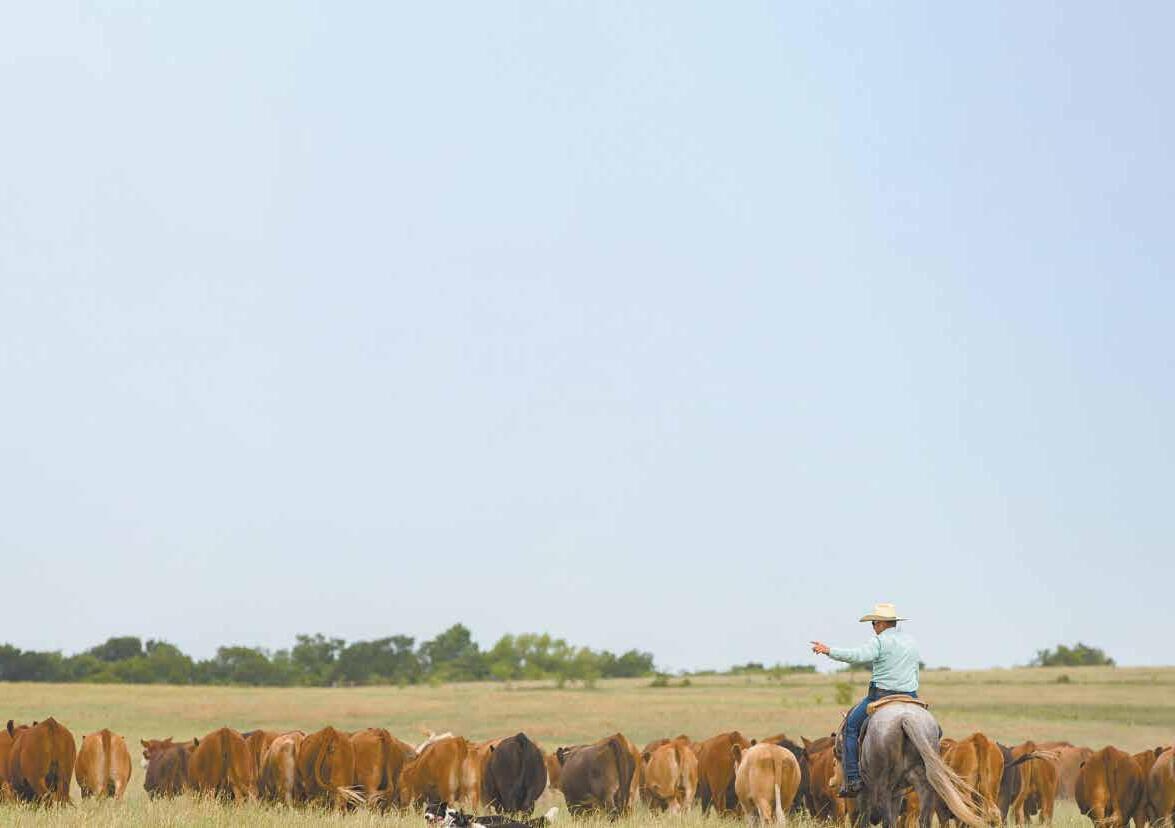
University of Nevada, Reno helps farmers in nation’s driest state meet water challenges
From sophisticated research to hands-on training, University helps Nevada get water smart
By John Seelmeyer
A doctoral student and his professor at the University of Nevada, Reno spend long hours at their computers, using highly sophisticated satellite data to create a map of the underground water resources in Nevada, as part of the University’s Experiment Station research.
In the Diamond Valley of central Nevada, meanwhile, a specialist with the University’s Extension unit supports alfalfa farmers with new practices that use less water while still producing abundant crops.
And outside a modest office building in the heart of Reno, professional landscapers pay close attention as they master the techniques of water-smart residential irrigation in a workshop also overseen by Extension.
It’s all part of efforts by researchers, students and outreach specialists with the University’s College of Agriculture, Biotechnology & Natural Resources to help the driest state in the nation – a state that continues to feel the effects of a shifting climate – by focusing on the discovery and implementation of practices that ensure the best-possible uses of Nevada’s limited water resources.
Mapping hidden water resources
A fundamental question – how much water is available in Nevada’s underground aquifers? – may find answers through advanced analysis undertaken by Robert Washington-Allen, an associate professor in the College’s Department of Agriculture, Veterinary & Rangeland Sciences.

Doctoral student Weylin Gilbert used data generated by NASA satellites that carefully track tiny changes in the Earth’s gravity field to help map Nevada’s groundwater.
To map water resources hidden away hundreds of feet below the surface, Washington-Allen and doctoral student Weylin Gilbert use NASA’s Gravity Recovery and Climate Experiment (GRACE) satellites that track tiny changes in the Earth’s gravity field due to changes in the Earth’s mass.
“We can detect changes in the mass of an aquifer using GRACE and translate these into changes in the height of the water column with an accuracy of 1 centimeter,” Washington-Allen said.
Gilbert is now combining the satellite data with historical information from private and public wells in the state as he seeks to generate maps of underground water resources in the state.
“Nevada is a difficult study area for this type of project because the geology is very complex,” Gilbert said. “But, since water is so scarce here, it’s one where this work should be useful. And even when I invest time applying some modeling technique that doesn’t seem to make any progress, I’ve still explored something that might be effective in a different study area. One thing I

love about scientific research is that there are few true dead ends. Sometimes you’re just learning about something different than what you expected to learn about.”
The work, part of an initiative known as NevadaView, is more than an academic exercise, said Washington-Allen.
Drylands by definition are water-limited ecosystems,” he said. “Groundwater is a renewable resource, but because extraction has exceeded recharge in many places in the West and around the world, this resource is in decline.”
Continued research, Washington-Allen said, may provide even more detailed mapping of water resources and focus on how quickly aquifers are declining.
Using agriculture water precisely
Very precise use of irrigation water – enough generate maximum crop yields under a limited water budget, but not a drop more – on the most important crop in Nevada is the goal of research led by Alejandro Andrade-Rodriguez, assistant professor of water and irrigation management, also in the College’s Department of Agriculture, Veterinary & Rangeland Sciences.
Researchers led by Andrade-Rodriguez test combinations of several technologies and irrigation schedules on alfalfa crops grown at the University’s Valley Road Field Laboratory, part of the College’s Experiment Station. Their goal: determining which combination delivers the highest yields with restricted water use and creating tools that allow farmers to put that knowledge to use.
It’s a critically important issue in Nevada, Andrade-Rodriguez said, because alfalfa is the state’s leading cash crop but requires substantial irrigation. Farmers are under increasing pressure to reduce their water use as the result of the depletion of groundwater reservoirs, increased water demands from a growing population and the effects of a shifting climate.
The research at the Valley Road Field Lab relies on several types of sensors to monitor soil moisture in different parts of a field, as well as infrared thermometers installed above the plants to estimate the amount of moisture they lose. The research so far indicates that carefully targeted irrigation strategies can reduce alfalfa water consumption by 20% while causing only a 5% reduction in seasonal dry yield. A further reduction of 40% in alfalfa water consumption results in only a 14% percent reduction in seasonal dry yield.
The next step, Andrade-Rodriguez said, is further development of decision-support software and artificial-intelligence tools that use the research results in combination with weather data, soil-moisture sensors and infrared thermometers to help farmers determine the best irrigation strategies for their individual fields.
The research, funded by two grants of $298,000 and $784,000 from the USDA’s National Institute of Food and Agriculture, is planned to continue until 2027.
A pivot with a LESA (Low Elevation Sprinkler Application) in Diamond Valley, Nevada, sprays closer to the ground for greater water-use efficiency.
Photo by Gary McCuin.
Educating for efficiency
These new irrigation strategies are vitally important in the Diamond Valley north of Eureka in Central Nevada, where Extension continues to support farmers who are changing their practices after watching the level of the aquifer that supplies their wells drop an average of 2 feet per year.
After decades of allowing farmers to draw far more water from the aquifer than was replenished from winter storms, the Nevada State Engineer in 2015 declared the Diamond Valley a “critical management area.” Farmers were given 10 years to develop a plan that would prevent some – perhaps up to half – of them, from losing all of their access to groundwater for irrigation.
To help meet the requirements of the plan, the research and demonstration projects by Gary McCuin, Extension agriculture and natural resource educator in Eureka County, and Howard Neibling, irrigation specialist with University of Idaho, in collaboration with Marty Plaskett, a local farmer and irrigation equipment dealer, initiated a shift in Diamond Valley to transition from the use of traditional midlevel irrigation sprinklers (MESA) to low-elevation spray application (LESA) systems, with sprayers closer to the ground and spaced closer together. This change provides for more efficient water use by reducing the amount of water lost before it reaches the ground.
The conversion increased irrigation efficiency from 60% to 70% to over 80% efficiency, resulting in substantial water savings. Now McCuin is working to encourage adoption of soil moisture measurement and analysis technology, as well as implementation of the six soil health principles and sustainable farming practices, which will increase water retention.
McCuin said that in the long run, the requirements of the state-mandated plan to reduce water usage, along with changes in crop production and economics, provide motivation for improved irrigation and improved farming practices. A shift toward improving soil health, increasing soil biology and organic matter, and improving soil aggregation to capture and retain water will increase the potential for longterm farm sustainability. But, he added, the process takes time, patience, and more importantly, a paradigm shift from historic cultural practices.
“It’s never as easy as people sometimes suggest it is,” he said.
Finding collaborative approaches
A shifting climate raises increasingly challenging questions about management of water in Nevada and across the West. How will water be allocated among the competing needs of cities, farms, industries, Native American tribes and the environment when there isn’t enough water to go around?
A multidisciplinary team at the University is working closely with water users to understand present allocation institutions and how they could be strengthened to help communities adapt to changing water availability.
A key early finding: People in local communities are eager to work with scientists to develop collaborative approaches, said Loretta Singletary, a professor and interdisciplinary outreach liaison in Extension and the University’s Department of Economics in the College of Business.
“By engaging stakeholders in its production, scientific research becomes more transparent and legitimate to stakeholders,” a team led by Singletary wrote in research published in Socio-Ecological Practice Research. “In contributing to research, stakeholders acquire a sense of ownership of the research processes and outcomes.”
Those findings now are blossoming in a project dubbed SNOWPACS, an acronym of “Synthesizing KNowledge to Optimize Water Policy for Agriculture under Changing Snowpack.” The initiative is led by Michael Taylor, a state specialist with Extension and associate professor of economics, and was funded by a $4.9 million grant from the USDA National Institute of Food and Agriculture.
In Nevada’s Walker River Basin and Colorado’s South Platte River Basin, SNOWPACS is working with local communities to prepare for changing water supplies as it brings together agricultural producers, hydrological scientists, economists and the water-allocation institutions that establish the rules for water use in the West.
...continued next page


A variable irrigation system at the University’s Valley Road Field Laboratory allows researchers to deliver very precise amounts of irrigation water to alfalfa crops.
Photo by Alejandro Andrade-Rodriguez.
Gary McCuin, Extension agriculture and natural resource educator in Eureka County, sets up a soil moisture sensor station in a Diamond Valley, Nevada, field.
Photo by Jim Evans.

Taylor said the work is urgent and complex as communities wrestle with the complexities of wide swings in annual snowpack as well as ever-earlier snow melts that often don’t bring water to users when they need it most. The team has produced a video, “Water Markets of the Walker River Basin,” explaining the issues and their work to help address them.
SNOWPACS is funded by the USDA’s National Institute for Food and Agriculture.
Training skilled farm professionals
Equipping agricultural producers with water-efficiency strategies is key to sustainable farming in Nevada. The University’s Desert Farming Initiative incorporates innovative practices such as precision irrigation into training programs for University students and aspiring farmers within the context of its working fruit and vegetable farm.
In 2025, the Desert Farming Initiative trained two apprentices and six students, said the Initiative’s director, Jill Moe. The program, part of the Experiment Station unit, also hosts a steady stream of agricultural industry support programs, tours and University class visits that include discussion on equipment and technology for small farm irrigation management.
Hands-on work in the setting of a commercial farm has proven to be a powerful learning tool.
“At DFI, we use drip tape, which has a high water-use-efficiency rate, paired with an irrigation schedule that is less frequent,” said Vanessa Mackessy, a student who worked at the farm last year. “This allows for the water applied to infiltrate and reach the rooting zone, reducing the evapotranspiration rate and keeping moisture deeper within the soil profile. Work at the Desert Farming Initiative has been an amazing experience allowing me to learn and grow alongside the crops we plant. The sense of pride and accomplishment is indescribable.”
Experienced farmers and ranchers, meanwhile, participate in industry programs to meet the challenges of farming in an arid, windy region. These programs are informed by research conducted at the Desert Farming Initiative.
“Nevada presents multiple obstacles for the fruit and vegetable grower,” said Rob Holley of Holley Family Farms of Dayton. “The relative lack of precipitation, the harsh climate and limited irrigation water supplies pose particular challenges. The techniques employed at DFI offer solutions and alternatives for experienced farmers to moderate the effects of our climate and more efficiently and effectively utilize their available irrigation supply. These practices result in more food produced from less total space, with the same, or possibly even less water applied.”
Although the Desert Farming Initiative’s purpose is to provide training and conduct research that answers pressing questions from producers, its farm at the Valley Road Field Lab also helps feed the region. Last year, it produced 10,400
pounds of produce, such as tomatoes, carrots and melons, that primarily supported food pantries on the University campus and in Reno. All farm revenue is directed right back into training and industry-support programs.
Improving landscaping efficiency
While the Desert Farming Initiative and other University programs seek to help agricultural producers use water more efficiently, the University also conducts numerous programs to help landscape professionals and homeowners use water resources wisely. Residential landscaping, with crops of turf, trees and bushes at homes, parks and golf courses, accounts for 70% to 75% of water use in Nevada, is another focus of the University’s Extension unit.
Some 103 landscapers and nursery professionals statewide have been certified under QWEL – that’s shorthand for “Qualified Water Efficient Landscaper” – since the three-day program was launched by Extension in Nevada in 2018.
“Local landscapers and other green-industry professionals often lack basic information on irrigation efficiency and landscape sustainability,” explained Heidi Kratsch, a professor and sustainable horticulture specialist with Extension. “Our program provides the critical information needed to make sure the water we apply to our landscapes is used efficiently.”
Water-efficient turf management is an important topic, too, in the Green Industry Continuing Education series offered by Extension to entry-levels workers in the industry. Protection of water from pollutants, meanwhile, is also important in managing our water resources, and integrated pest-management courses coordinated by Extension appear to be making a difference.
Pesticide safety education courses, for example, drew 164 participants during sessions this spring and last fall. Carrie Jensen, the coordinator of pesticide safety education and urban integrated pest-management programs, said pesticide professionals appear to be putting its lessons into practice.
Over 10 years of our programming, studies show a significant decrease in pesticide residues in Nevada waterways, despite population growth,” Jensen said.
That’s the kind of impact the University is looking for. Whether it’s improving water quality in our rivers, finding ways to use new technology to irrigate more efficiently, or training the next generation of farmers in the classroom and in the field, the far-flung initiatives share a common goal: a commitment to preparing Nevada and other arid regions to adapt to changing conditions that require more efficient management of our water resources.

The irrigated croplands of the Mason Valley near Yerington will be affected by shifts in climate and changes in the water supply in coming years.
Photo by Vanessa de la Cruz Pavas and Kelsey Fitzgerald.
Students and apprentices graft tomatoes for the Desert Farming Initiative farm and other farms in the region, allowing them to achieve better yields in a shifting climate. Left to right: Jessica Osgard, Vanessa Mackessy, Monica Mori and Jesse Vazquez.
Photo by Jill Moe.
NV Energy Partners with UNR to expand ALERTWildfire camera network across Nevada
53 new fire cameras to be installed by the end of 2026
By Michelle Werdann
New wildfire detection cameras will help fill critical gaps in coverage across Nevada, enabling public safety partners to make faster, more informed decisions during wildfires. This expanded capability comes after NV Energy received approval from the Public Utilities Commission of Nevada to support the installation of 53 new cameras operated by ALERTWildfire, a network managed by the University of Nevada, Reno.
The permanent installations include 35 cameras in Northern Nevada and 15 in southern Nevada, all expected to be in place by the end of 2026.
“The ALERTWildfire network is becoming more robust with every camera installation, and these new cameras fill critical coverage gaps throughout the state,” said Bill Savran, director of ALERTWildfire.
The expansion is part of NV Energy’s Power Safe NV initiative, which aims to enhance wildfire mitigation and response. In addition to installing new cameras, the company has added hazard awareness specialists to its team to improve situational awareness and enable faster, more targeted emergency responses. This deployment will triple the capacity of ALERTWildfire cameras supported by NV Energy, which has partnered with ALERTWildfire for the past seven years.
Of the 50 new permanent cameras, 20 are short-range units that can be installed on powerline infrastructure in high-risk areas with limited visibility. The remaining long-range cameras will be installed on mountaintops to maximize visibility.
NV Energy will also deploy three mobile cameras that can be rapidly positioned during severe fire weather or active wildfires. The mobile cameras help fill coverage gaps in areas unsuitable for permanent installations.
Camera feeds are publicly accessible and have been proven to be effective in helping emergency responders scale their operations. Firefighting agencies can view live images and remotely control the cameras, which feature pan-tilt-zoom capabilities for enhanced monitoring.
“The wildfire cameras are an invaluable resource in the fight to prevent catastrophic wildfires,” said Jesse Murray, NV Energy’s senior vice president of energy delivery. “By increasing this coverage, first responders can bring resources quicker and communities can be notified of threats faster, potentially saving lives and property.”
Watch the video here: https://tinyurl.com/NVE-ALERTCameras


Melissa Huntley will lead Extension’s efforts in Lyon and Mineral counties to connect residents with programs to address county needs such as enhancing family well-being, local agriculture and community resilience.
Photo by Robert Moore.
Extension hires new coordinator for Mineral and Lyon counties
Huntley to lead UNR programs supporting families, youth and agriculture
By Emma Lande
University of Nevada, Reno Extension has hired Melissa Huntley as the new Extension county coordinator for Lyon and Mineral counties. Huntley will partner with residents and local leaders to expand access to research-based education in areas such as agriculture, youth development, health and nutrition, and community development.
A lifelong Nevadan with deep roots in Lyon County, Huntley brings extensive experience in public service, community programming, and support for families and underserved populations.
“I’m excited to work with our local communities in a new capacity, helping families, youth and local organizations access educational resources that truly make a difference,” Huntley said. “Extension’s work reaches every corner of Nevada, and I’m honored to continue that legacy here at home.”
Before joining Extension, Huntley worked in multiple roles with Lyon County Human Services and the State of Nevada’s Rural Regional Center, where she provided case management, quality assurance and resource coordination for vulnerable populations. Her leadership experience includes supervising senior services programs and staff and fostering community partnerships.
As the Extension county coordinator for both Lyon and Mineral counties, Huntley will manage the Extension offices in those counties, located in Yerington and Hawthorne, ensuring that local programs meet county needs while connecting residents to statewide University resources.
“Melissa’s background in community service and local government makes her an excellent fit for this position,” said Holly Gatzke, Extension northern area director. “She brings both professional expertise and a heartfelt understanding of the people and priorities of rural Nevada.”
An alum of the University of Nevada, Reno, Huntley holds a bachelor’s degree in speech pathology.

UNR Extension hosts virtual fencing workshop
Participants learn about the University’s research and how they can apply the technology in their operations
Virtual fencing is a technology that can help Nevada ranchers and land managers protect riparian environments while successfully managing grazing and rangelands in the state.
On Sept. 26, University of Nevada, Reno Extension hosted a workshop in Fallon on using virtual fencing and regenerative practices to promote water quality and soil health. About 40 participants learned about the University’s virtual fencing research and how to apply the technology in their own operations.
The workshop was sponsored in part through funding and in-kind contributions from the Nevada Agricultural Foundation, Western SARE, and Carson Water Subconservancy District. Rambling River Ranches hosted the riparian grazing tour and the practice session for attendees to learn to fit collars correctly.
Tracy Shane, state livestock Extension specialist, opened the workshop by giving an introduction to virtual fencing. She presented the concepts and definitions used for describing how virtual fencing works and the recent developments that have improved connectivity and function. Next Joe Frey, an Extension regenerative agriculture instructor and local rancher, focused on his approach to riparian grazing management and grazing management practices in general. Paul Meiman, Extension range and wildlife specialist, then presented his virtual fencing research work with ranches in eastern Nevada. He has over five years of experience working with virtual fencing and has seen rapid changes and developments in the technology. Kathryn Dyer, BLM state range management specialist, presented the policy implications on public lands for virtual fencing. University graduate student Austin Lemons then presented his research on the use of virtual fencing for targeted grazing on cheatgrass.
After a break, the group learned more about how topography can play into the challenge and success of using virtual fencing to manage riparian grazing from Liz Duncan, with Willow Creek Land and Cattle. Joel Yelich, scientific affairs rangeland specialist from Vence SenseHub™, a Merck Animal Health subsidiary, presented several of the successes their clientele had across the Intermountain West using virtual fencing to manage grazing in areas where clear no-graze areas had to be maintained due to recreation uses or wildfire closures. Sharl Liebergreen, of Gallagher eShepherd™, presented virtually from Urugay and shared not only some of the differences between technology and platforms, but also how wheel-spoke designs and off-site water can be used to achieve livestock grazing objectives. The last in-class presentation of the day was on virtual fencing cost-share contracts from Angela Mushrush, state range management specialist with the Natural Resources Conservation Service.
Following the classroom-style presentations, the group moved out to a lunch hosted at Rambling River Ranches. Brenda Hunt with Carson Water Subconservancy District and Joe Frey presented the work that they are planning along the Carson River to reduce bank angles, encourage beneficial

Above: Tracy Shane presenting examples of virtual fencing livestock collars
At Right: Joe Frey discussing regenerative Ag and approach to Riparien Grazing Management
Below : Joe Frey and Katheryn Dyer, BLM State Range Management Specialist
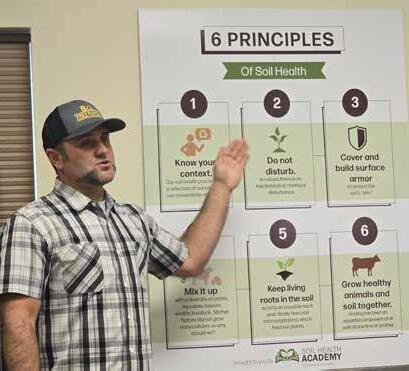

species including cottonwood saplings, promote soil health, and reduce weeds through bale grazing on the benches along the river. Frey has been using electric fencing to control cattle movements and access to water along the river and looks forward to trying virtual fencing as another tool to change and adjust grazing management along the river. The day ended with a demonstration of fitting collars on cattle, tips for what to look for regarding proper fit, and tips for handling cattle in chutes to reduce fitting time. The workshop was the first of its type to be held in Nevada.
Watch for more information on the collaborative work the University is doing on virtual fencing and range management in future issues of the Progressive Rancher.

Grand opening showcases University’s new Main Station Farm Science Center
Faculty supports essential animal and meat science learning and research
The University of Nevada, Reno, celebrated the grand opening of the Experiment Station’s Main Station Farm Science Center on Oct. 10. The event, hosted by the College of Agriculture, Biotechnology & Natural Resources, marked a debut of a new classroom and research facility designed to foster discovery, innovation and hands-on learning for students while supporting Nevada’s agricultural and meat industries. The facility features state-of-the-art technology that will enhance and support several of our programs, including meat science, animal science and veterinary science—areas critical to meeting the state’s needs.
Guests toured the Science Center’s lab and collaborative spaces as well as the newly upgraded feedlot and Wolf Pack Meats. University leaders, including President Brian Sandoval; Provost Jeff Thompson; College Dean Bill Payne; and Associated Students of the University of Nevada, Reno Senator Grace McAndrews, shared remarks. Attendees enjoyed homegrown refreshments featuring wine from the University’s Desert Farming Initiative and beef from Wolf Pack Meats, celebrating a milestone that strengthens both student learning and Nevada’s agricultural community.
The Science Center features a modern smart classroom that seats 46 students and is equipped with integrated presentation technology and high-speed WiFi, ideal for lectures, workshops or hybrid instruction. The Web Lab offers a specialized environment for animal science education, including a cameraequipped necropsy (animal autopsy) table, rail systems for safe specimen handling, coolers and freezers, and a load bay for efficient transport. The facility also features a conference room, a fully equipped kitchen and an outdoor patio, providing versatile spaces for meetings, demonstrations and gatherings.
Development of the facility began in November 2020 and concluded in December 2024. The project is an investment in Nevada’s food security and food systems, and enhances the College’s ability to recruit students to its programs supporting food systems and security in the state through its unique combination of classroom, lab, Wolf Pack Meats and feedlot operations.
1: University
Image 2: University faculty, students and community members tour the newly upgraded feedlot at the University’s Experiment Station’s Main Station Farm.
3

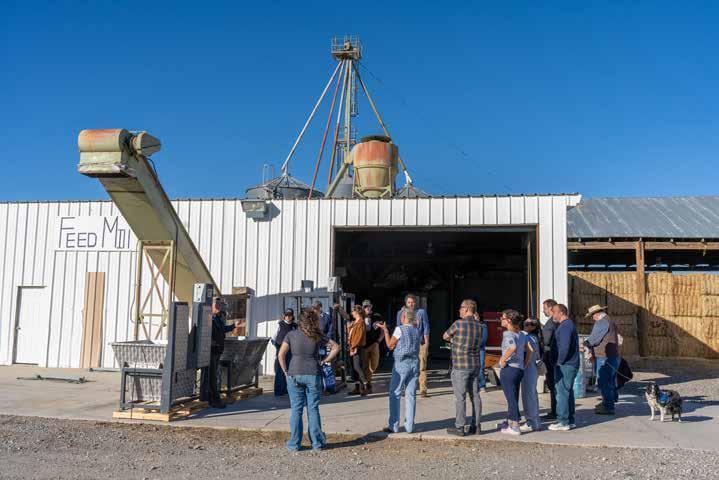

Image
of Nevada, Reno President Brian Sandoval gives remarks at the Experiment Station’s Main Station Farm Science Center Grand Opening on Oct.10. Photo by Robert Moore.
Photo by Robert Moore.
Image
: University of Nevada, Reno Vice President and Provost Jeff Thompson gives remarks at the Experiment Station’s Main Station Farm Science Center Grand Opening on Oct.10. Photo by Robert Moore.
#2
#3
Extension showcases unique opportunities for Nevada youth offered by 4-H
4-H kicks off the 4-H year, encourages youth and parents to check out local programs
In schools across our state today, things might be looking a little more “green.” That’s because, with the new school year underway, so are 4-H youth development clubs and activities, and today is “Go GREEN Day,” where 4-H youth, volunteers and staff are encouraged to wear green as a kick-off to the new 4-H year and to National 4-H Week, Oct. 5 – 11. Here in Nevada, the program’s leader says 4-H activities have evolved significantly from the organization’s rural roots over 100 years ago, with one Nevada youth recently even earning his private pilot certificate through a local 4-H program.
“Today’s 4-H clubs and activities go beyond raising animals and other traditional activities that many may think of, although those clubs are still a valuable part of our offerings,” said Lindsay Chichester, Nevada 4-H Program leader with University of Nevada, Reno Extension. “Our kids are also doing hands-on activities to learn about things like robotics, selfdefense, sign language, creative writing and even hot air ballooning. 4-H has become the largest youth development organization in the country because we’ve adapted to include a variety of activities to reach youth in both urban and rural communities. But, what’s consistent across all our activities is that they aim to equip young people with the skills, confidence and resilience needed for career-readiness and to provide leadership and service in their communities and beyond as adults.”
Kicking off the 4-H year: time for youth to get involved
During National 4-H Week, and throughout the month, Chichester and her statewide 4-H team are encouraging youth and parents who may be interested in learning more about 4-H to get involved by attending a local 4-H activity or by reaching out to their local county 4-H office for more information.
Here in northern Nevada, one event youth and their families can attend is the 4-H Kickoff Event, Oct. 23 at 5:30 p.m., in Reno at the Extension Office, 4955 Energy Way. Leaders and members of various clubs will be on hand offering activities, providing information on their clubs, and helping interested youth get signed up for the new 4-H year. Clubs focusing on livestock will begin at 5:30 p.m., while all other clubs will begin at 6 p.m.
In many Nevada communities, youth activities can be scarce or costly, Chichester said, and 4-H engages with the partners and volunteers in the community to address that.
“4-H strives to provide free or very affordable, unique and meaningful educational experiences to engage Nevada youth across the state, from those tucked away in our most rural areas to those in heavily populated urban centers,” she said.
Just a few highlights this year include 4-H youth learning about wild mustangs and land management at a Mustang Camp; learning about civic engagement by providing Christmas tree ornaments for a Nevadagrown tree that will be displayed as the 2025 U.S. Capitol Christmas Tree in Washington, D.C., and learning about what it takes to get a pizza on their plate by growing and producing their own ingredients –even grinding their own grain to make flour.
Immersive camps: youth explore today’s complex issues
At the overnight 4-H Mustang Camp held this July in Eureka, Nevada, 4-H youth from Nevada and across the West learned about managing public lands, rangelands, wild horses and burros. The goal was to look deeper at the relationship between healthy lands and healthy horses. The program was a collaboration among our University of Nevada, Reno Extension; along with Utah State Extension; University of California Cooperative Extension; and the BLM’s Wild Horse and Burro Program.
During the first day of the camp, youth spent some time in the classroom, learning about the mustangs and the ecosystem that supports them, as well as other animals, plants and grasses. Then, they moved out onto the range, where everything they had learned about “came to life,” according to Tosha Kerby, a 4-H instructor with Extension in Eureka County.
“The youth were thrilled to see the wild horses, especially the foals,” she said. “It was incredible to watch their curiosity grow as they explored – finding animal tracks, seeds from plants and even bones. They immediately began discussing and debating what each item they found might be. One of the youth said while eating our lunch out on the range, ‘Imagine if we had to walk 20 miles to get a drink.’ This was a great observation, as we had not seen a water source for the horses in quite some time, and one we found was dried up.”
The second day was spent touring the Palomino Valley Wild Horse and Burro Center, 30 minutes north of Reno. By the end of the day, many of the youth were wanting to attend the camp again next year and bring some friends with them, and a few of them had started to plan how they could adopt a horse themselves. Kerby said that through the camp, the youth had also come to realize that in addition to ensuring the mustangs remain a part of our Western ranges for years to come, it’s also important to care for the land and all the wildlife on the range. She added that, like at all 4-H camps, the youth also learned about teamwork and responsibility.
“The Mustang Camp provided a safe environment where our kids were also able to build confidence, develop practical skills, and form positive relationships with both animals and peers,” she said.
At 4-H day camps and overnight camps in Nevada, thousands of youth each year gain hands-on learning experiences and make lifelong friendships and memories. At the Nevada State 4-H Camp in Lake Tahoe, 4-H has been offering summer camps for more than 80 years, and a couple of years ago, 4-H also began offering camps at Nevada 4-H Camp Alamo, 100 miles north of Las Vegas.
Bringing Nevada spirit to the nation’s Capitol this Christmas
In January, the Humboldt-Toiyabe National Forest announced that it has been selected to provide the 2025 U.S. Capitol Christmas Tree, marking the first time the U.S. Forest Service will harvest the tree from the HumboldtToiyabe and from the state of Nevada. The U.S. Capitol Christmas Tree is a tradition that began in 1964 in which one of America’s 154 national forests provides a tree for the West Lawn of the U.S. Capitol for the holiday season. The Humboldt-Toiyabe National Forest is the largest in the continental United States, encompassing more than 6 million acres in Nevada and California.
With a theme for the tree of “Starry Skies to Neon Lights – Spirit of the Silver State,” the U.S. Forest Service put out a call in May for 10,000 handmade ornaments, ranging from 4 inches to 12 inches tall, that will be required for the gigantic tree. Youth in Nevada 4-H and Cloverbuds (ages 5-8) joined others across the state to help answer the call and have the ornaments delivered to the Forest Service by Sept. 15. The 4-H and Cloverbud youth provided a variety of handmade ornaments showcasing their artistic talent, as well as what makes our state unique and what “Home Means Nevada” means to them. The Forest Service specifically asked that ornaments reflect Nevada traditions and people; iconic landscapes and special places; our public lands and how people enjoy them; and our wild plants, animals and geology.
Anna Whiteside and Sara Sweeney, from the Extension office in northern Nye County, helped coordinate the effort for more than 20 4-H youth in Tonopah and Round Mountain to make 50 ornaments to be sent to the White House. The ornaments were made of wood and hand-painted, or were crafted from other art supplies, many of them depicting Nevada wildlife or “Battle Born,” as displayed on the state’s flag. Sweeney said the youth were excited to represent Nevada and contribute to the effort.
“They were also very excited about where the ornaments were going to be displayed,” she said. “One of the younger kids said, ‘This ornament is going to be famous, so I am going to try my best.’ They had a lot of fun, but they also took it pretty seriously and put a lot of thought into their ornaments.”
Youth in other areas of state also participated. Douglas County 4-H youth provided hand-painted Nevada-shaped ornaments, many of them depicting starry skies or eagles. Youth from Lyon County provided hand-painted, wooden, horse-themed ornaments. Youth from Pershing County provided hand-sewn ornaments.
The U.S. Capitol Christmas Tree project is made possible with support from partners, including nonprofits Society of American Foresters and Sierra Forever, along with contributions from companies and volunteers across America. Encouraging volunteerism, community service and leadership, and civic engagement is a pillar of the 4-H Youth Development Program. In fact, 4-H youth are four times more likely to contribute to their communities and two times more likely to have the goal of being a leader than their peers.
A camper at the 4-H Mustang Camp plays peekaboo with a mustang at the Palomino Valley Wild Horse and Burro Center.
The campers also spent time in the classroom and on the range, learning about managing public lands, rangelands, wild horses and burros.

Growing informed consumers: from seed to plate
Youth in White Pine County got to experience firsthand what it takes to get a pizza on their table by participating in the 4-H Grow a Pizza Program. Held at the Boys and Girls Club in White Pine County, youth planted and harvested wheat, used a mortar and pestle to grind wheat berries to make flour, and made the dough for the crust from it. They also grew tomatoes, basil and parsley; and made mozzarella cheese. The last day of the program, youth made mini pizzas and got to eat their creations. The goal of the program was for youth to appreciate all of the steps it takes to get food on their tables, providing education on our food system, from farm to table.
Youth in 4-H engage in similar activities throughout the state, engaging in clubs that teach cooking, food safety, nutrition, and gardening and horticulture. Besides gardening, many other 4-H clubs include healthy physical outdoor activities, from skiing to horsemanship and fishing. “Health” is one of the 4 H’s of 4-H: Head, Heart, Hands and Health. 4-H members are nearly twice as likely to make healthier choices and are more likely to be physically active than their peers.
Nationwide, the 4-H Youth Development Program reaches nearly 6 million young people through experiences that develop critical life skills. Through the 4-H Beyond Ready national initiative, 4-H aims to increase that number to 10 million youth annually by 2030. 4-H is the youth development program of our nation’s Cooperative Extension System and the USDA and serves every county and parish in the U.S. through a network of 110 public universities and more than 3,000 local Extension offices. In Nevada, Extension is a unit of the College of Agriculture, Biotechnology & Natural Resources at the University of Nevada, Reno. Globally 4-H collaborates with independent programs to empower 1 million youth in 50 countries with research-backed 4-H experiences.
In Nevada, persons in need of special accommodations or assistance for attending 4-H events should contact Paul Lessick, civil rights and compliance coordinator, at plessick@unr.edu or 702-257-5577 at least five days prior to the scheduled event with their needs or for more information.
Photo by Tosha Kerby.

The Results Oriented Grazing for Ecological Resilience (ROGER) group met in September at the Winecup Gamble Ranch to discuss ongoing grazing management on both private and federal lands in Nevada during the 2025 Field Tour.
Day one of the ROGER field tour began at the Winecup Ranch headquarters. Attendees gathered in a large circle for introductions, setting a tone of collaboration and curiosity. Each person took a moment to share their name, affiliation, what they were looking forward to during the tour, and how long they’ve been engaged with ROGER. Participants shared their excitement about seeing the results of recent habitat treatments, others were looking forward to discussing how large ranching operations like the Winecup Gamble balance production goals and ecological stewardship, and some folks were curious regarding the status and application of the ranch’s Outcome Based Grazing project (currently held up in litigation awaiting a judge’s decision). The sense of shared purpose across the group was palpable with over forty-five people from different backgrounds and agencies coming together to explore the convergence of livestock grazing, rangeland management, conservation, and community.
After introductions, the group loaded into vehicles and drove to the first stop of the day. Along the way, conversations in the trucks naturally turned to the unique character of the sagebrush community—the plants, wildlife, grazing and recreation that define so much of the Great Basin. This stop is an annual monitoring point suggested for the Winecup Outcome Based Grazing project and offered a wide view of the surrounding landscape. The group also discussed the use of the recently published USGS Grazing Management Tool which serves as a database to help with management decisions across NV (link provided at the end of this article). Participants reflected on how the health of these rangelands underpins livestock production and wildlife habitat, supporting species like sage-grouse, antelope, and mule deer. There was broad agreement that managing landscapes like this one requires close partnerships between private landowners, federal agencies, and conservation partners, each bringing their own unique resources to the table.
From there, the group traveled to an area identified by the ranch for brush treatment along a creek. This site has become dominated by decadent sage brush over time, reducing the diversity of grasses and forbs along the bank. The group discussed treatment
options, including mechanical removal, prescribed fire, and the trade-offs of each. Standing on the site during the field tour, it was helpful to visualize how targeted treatments could restore the balance of the landscape and improve the creek’s function. Building on this discussion, the ROGER Riparian Restoration Working Group has been created and will start meeting in October virtually to explore riparian management and restoration opportunities on the Winecup and throughout northern Nevada, working to share resources and strengthen coordination among partners.
Next, the group caravanned upstream to a stop that had already undergone brush treatment several years earlier during the building of a new fence along the same creek. Here, perennial grasses and sedges had re-established, the floodplain was expanding, and the overall function of the creek reflected a healthier, more productive system. The Winecup team described how the riparian vegetation crept in after the brush removal, emphasizing the importance of adaptive management and learning from results on the ground. Seeing before-and-after opportunities when comparing the two tour stops provided valuable insight into what success can look like when creative management activities are explored.
Day one ended back at the ranch headquarters for dinner. Conversation flowed and folks shared what they had seen, what the next steps might be for management, and how they might integrate their own resources here and on other projects across NV. This is truly the camaraderie that defines the ROGER network. Beyond sharing technical knowledge, gathering this community also strengthens relationships across a multitude of interest groups that are essential for the collaborative management of these rangelands.
Day two began with a crisp, clear morning as the group set out. The first stop of the day focused on a pipeline and troughs that had been installed to improve water availability on the BLM allotment. This was part of a maintenance project on an existing water line—an infrastructure upgrade that is making a big difference on how the cows are using this section of the permit. Joe Glascock, ranch manager for the Winecup, shared that these new troughs help disperse the herd and take grazing pressure off mountain springs that the group could look up and observe from the tour stop. Members of the Winecup crew explained how the system was designed, including a holding tank, 2-inch pipe, and two new troughs.
The group then traveled to a spring that is considered a management priority for the ranch, BLM, and NDOW because cows get stuck in the mud, but it serves as a water source for wildlife in the area so any efforts to keep livestock out of the spring need to allow for elk and deer to use. The shared concern for the site underscored the common goals that unite partners across the public-private spectrum, and particularly in ROGER where improving water resources are crucial for effective land management.
The final stop of the tour was on a portion of the recent Hot Canyon Fire. The blackened ground and emerging patches of green clearly displayed the cycle of disturbance and renewal that so many of us are familiar with in NV. The focus of the discussion turned to post-fire recovery and the strategies that the BLM is using to rehabilitate burned areas. Both BLM and University of Nevada Reno teams shared insights about how grazing management and reseeding plans could help the burn recover. The goal is to limit cheatgrass expansion, encourage sage brush establishment, and increase perennial grass cover. Despite the damage from the fire, there was a shared sense of opportunity to rebuild a strong plant community and learn from the event. To capitalize on this momentum, the ROGER Fire Rehabilitation Working Group has been established and will begin meeting virtually in October to discuss wildfire management on both the Winecup and northern Nevada in general with the goal of identifying resources and streamline efforts between partners.
As the tour wrapped up, participants reflected on the value of the two days spent in the field. The ROGER group continues to serve as an open platform for a broad array of partners—ranchers, conservationists, agency staff, and researchers—to gather and exchange ideas about livestock grazing and land stewardship in Nevada. The two-day tour at the Winecup provided more than just a series of site visits. It was a reaffirmation of shared commitment to the land and the communities that depend on it.
ROGER meetings are held the second Tuesday and Wednesday of January and April every year, in addition to a field tour that typically takes place in September. Anyone interested in positive impact to Nevada landscapes through grazing management and collaborative discussion is free to join the group. Please reach out to the group’s coordinator, Katlyn Mendive, for more information: katlyn@rci-nv.com
For access to the USGS Grazing Management Tool, use this link: https://rconnect.usgs.gov/GMT/




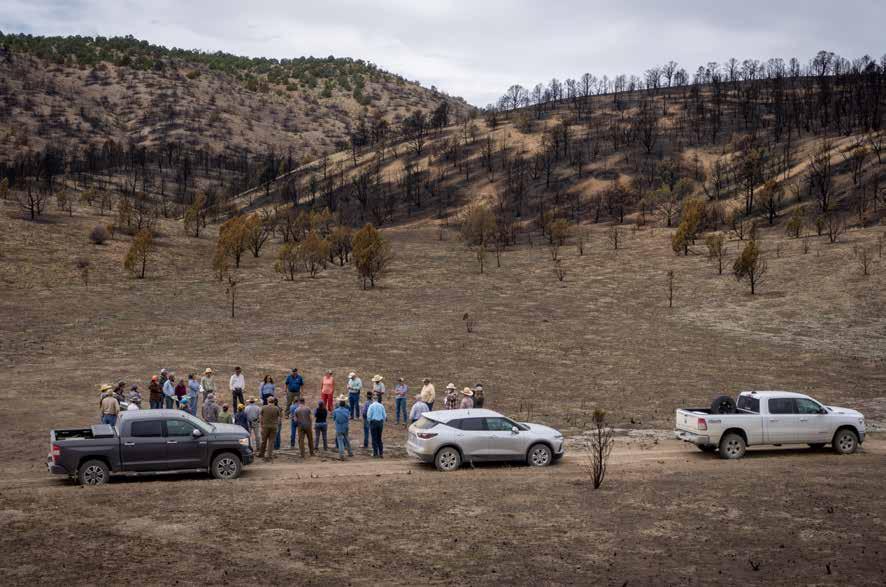


Cattlewomen’s Corner of the Corral 90th Annual Convention & Trade Show
I hope the busy fall season finds you getting good prices for your calves while you prepare your cows for another crop. I also hope you can attend the 90th Annual Convention and Trade Show. This year’s convention will be held in Elko, Nevada. The dates have been moved to a week earlier than previous years. The convention will be November 13-15.
The annual Nevada Cattlewomen general membership meeting will be held in conjunction with the convention on Saturday, November 15 at 9:00 am. We encourage all past, present, and future members to join us. We will be welcoming Brandee Mills from the American National Cattlewomen to share with us some of the great things ANCW has done over the year.
We will also be conducting our annual silent auction, although this year it will be done online. Last year we had great success when we moved the auction to our social media pages, so we will continue with that format. There will be QR codes posted around the convention to make it easier for people attending the convention to get online and see items to bid on. This is one of our biggest fundraisers, so we encourage everyone to join the auction online for great Christmas gifts.
As we wrap up 2025, I want to wish everyone a wonderful holiday season. This will be my last article as your Nevada Cattlewomen President. Thank you for all the support. It has been a great couple of years leading a wonderful group of women who are passionate about the beef industry.
Keri Pommerening
Keri Pommerening, NVCW President


US government cancels 6.2 GW Esmeralda Nevada solar project
The US Bureau of Land Management has scrapped the planned 6.2 GW Esmeralda 7 solar complex in Nevada, aligning with the Trump administration’s broader rollback of renewable energy initiatives.
By Ryan Kennedy
The United States Bureau of Land Management (BLM) has officially axed the Esmeralda 7 solar project, a project that would have smashed records as the largest solar facility in the United States.
The 6.2 GW solar project, located in Nevada, would have added enough electric generation capacity to power nearly 2 million U.S. homes. For context, the largest solar project in the U.S. is the Mammoth solar project in Indiana, a 1.3 GW currently project being built in phases.
The project’s NEPA environmental review had been stalled since Donald Trump took office. It is now officially listed on BLM’s website as canceled.
Despite campaigning on an “all the above” energy policy, the Trump administration has cracked down harshly on renewable energy development.
This July, the Department of Interior announced it will require “elevated review” for solar and wind projects on public land by Trump-appointee Secretary Doug Burgum. Projects seeking leases, rights-of-way, construction and operation plans, grants, consultations and biological opinions are now subject to approval by Burgum.
Kabir Green, director of federal affairs for nature at the Natural Resources Defense Council said the move imposes unprecedented scrutiny and bureaucratic roadblocks that could indefinity delay or delay clean energy projects on public lands.
“It is not about oversight, but about unfettered obstruction of wind and solar projects that create jobs, cut pollution, lower costs and strengthen communities. This policy protects select industry profits, not the public interest,” said Green.
The Esmeralda 7 project is comprised of seven projects developed by NextEra Energy Resources, Leeward Renewable Energy, Arevia Power and Invenergy. The projects would cover about 185 square miles of land, a land area close to the size of Las Vegas.
BLM’s cancellation of Esmeralda 7 moves in lockstep with President Trump’s message on Truth social late August: “We will not approve wind or farmer destroying Solar.”


Trump’s administration has taken a series of anti-renewables actions during his second term, on top of Congress’ clean energy-gutting One Big Beautiful Bill Act. Federal actions include:
• An executive order requiring that Treasury apply stricter qualifications for solar and wind projects seeking federal tax credits.
• The Environmental Protection Agency is clawing back $7 billion in Solar For All grant funding. The grants are intended to support community solar projects with guaranteed bill savings for low-income Americans.
• Solar and wind projects seeking to develop on federally owned land now face “final review” from Trump-appointed Department of Interior head Doug Burgum.
• Trump executive order directed the Department of the Interior to scrub for “preferential treatment” for wind and solar and eliminate such treatment.
• U.S. Department of Agriculture will “no longer” fund solar projects, like those made available to farms and small businesses via the $4 billion Rural Energy for America (REAP) grant program.
• President Trump implemented widespread tariffs to most goods, as well as energy component-specific tariffs and tariffs on critical materials like steel and aluminum.
Despite the many roadblocks, renewable energy is dominating new-build electric generation project queues. The Energy Information Administration (EIA) reported the U.S. is projected to have a record year for electric capacity buildout in 2025, adding 64 GW. The previous record was set in 2002, when developers added 58 GW of capacity, 57 GW of which was natural gas.
But this time, the record year for installations will be led by an emissions-free source instead. Solar is expected to account for 33.3 GW of the 64 GW added this year. This is followed by 18.3 GW of battery energy storage, 7.8 GW of wind and 4.7 GW of natural gas, said EIA.
Analysis from Lazard finds that solar and wind energy projects have a lower levelized cost of electricity (LCOE) than nearly all fossil fuel projects – even without subsidy.
PV Magazine USA has contacted the Esmeralda project developers and will follow up with more information on the cancellation listing on BLM’s site.
Governor Doug Burgum | U.S. Department of the Interior Wikimedia Commons

Horse enthusiasts from across the country joined together on September 12 and 13 at the Elko County Fairgrounds to admire and purchase some of the best horses the Great Basin has to offer.
High seller was Booners Romeo, a wonderful family horse consigned by Casey & Jacque Higgins, bringing $36,000.
TOTALS:
Total Gross: $741,250.00
Total Live Lots Gross: $741,250.00
Total Live Lots: 70
Average Per Live Lot: $10,589.29
Gelding | 26 Lots Grossed $399,450.00 To Average $15,363.46
Colt | 6 Lots Grossed $34,850.00 To Average $5,808.33
Filly | 15 Lots Grossed $82,700.00 To Average $5,513.33
Mare | 22 Lots Grossed $217,250.00 To Average $9,875.00
Stallion | 1 Lots Grossed $3,750.00 To Average $3,750.00
Save the date for next year’s sale, September 12 and 13, 2025. For more information, you can follow the Van Norman and Friends Production Sale on Facebook, or check out their website: www.vannormansale.com
Total sales: $741,250 For more information visit www.vannormansale.com


